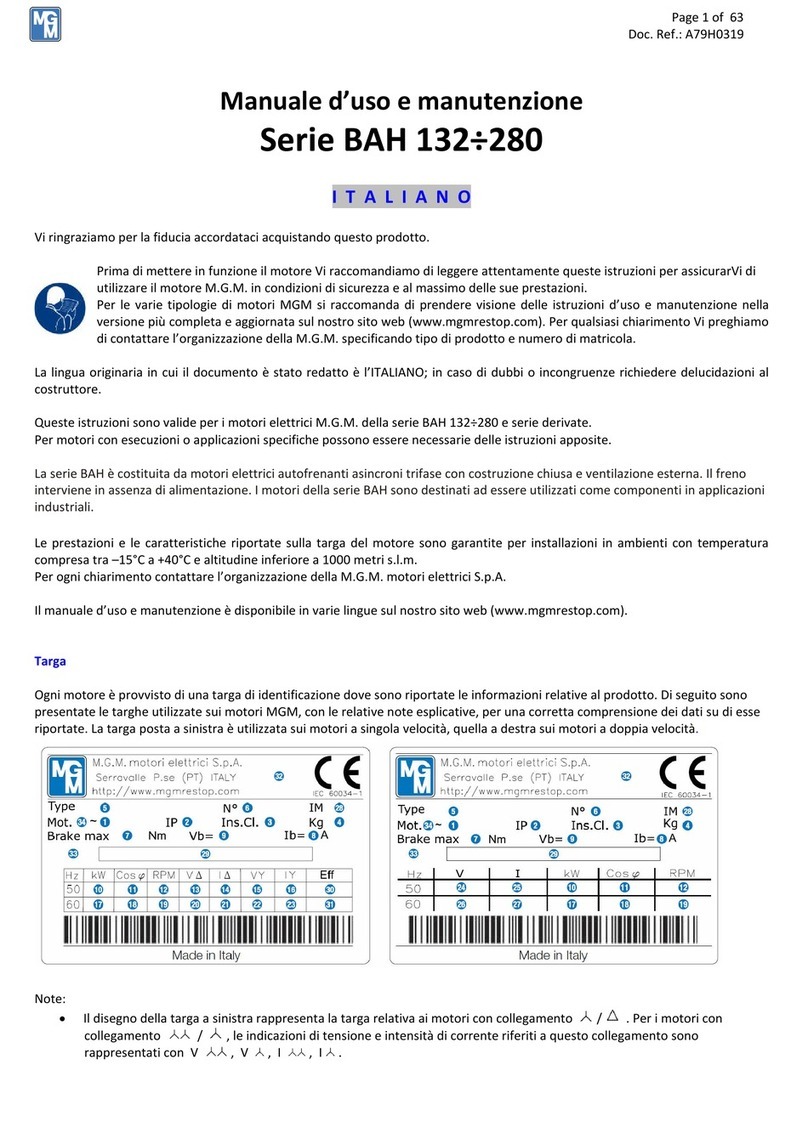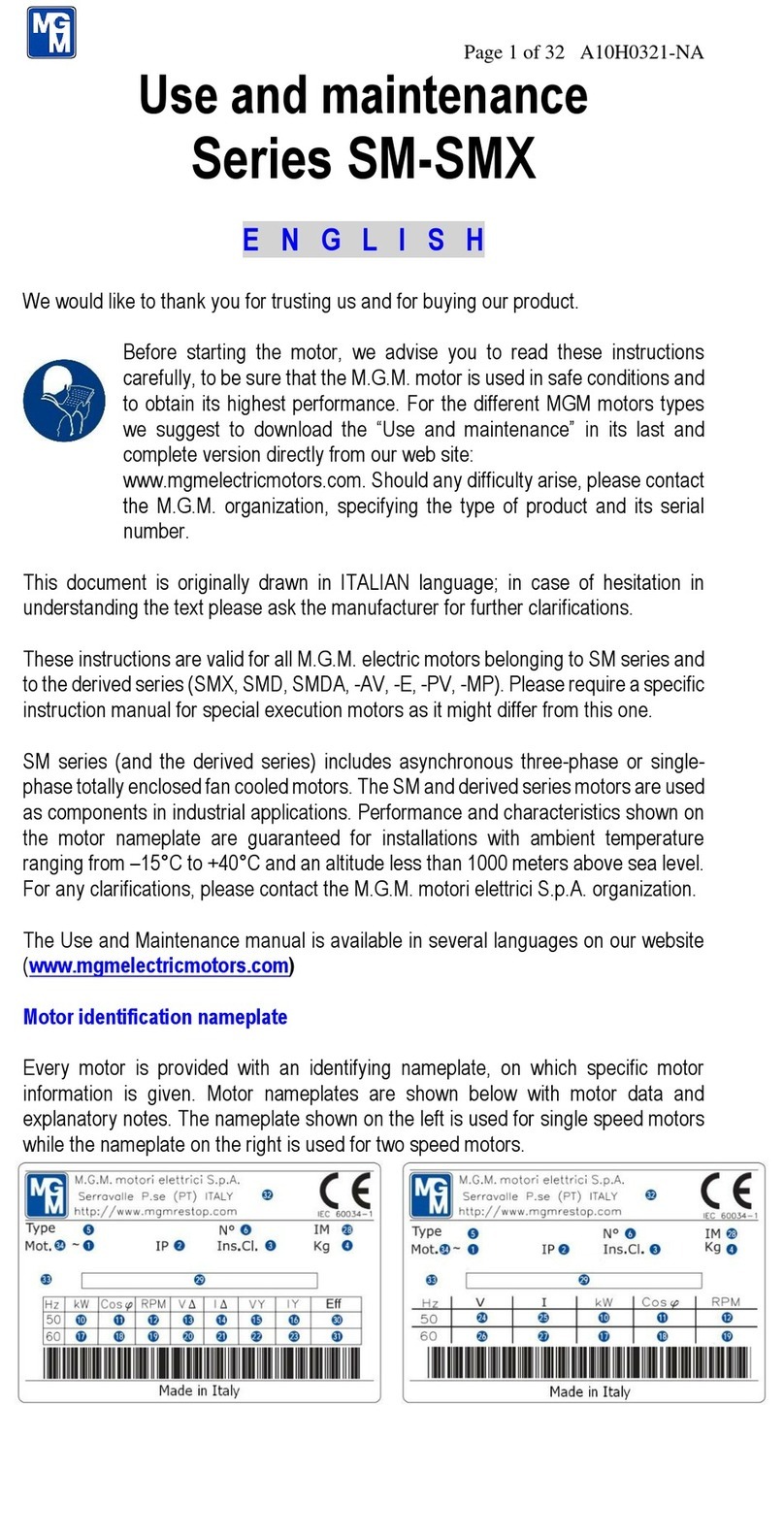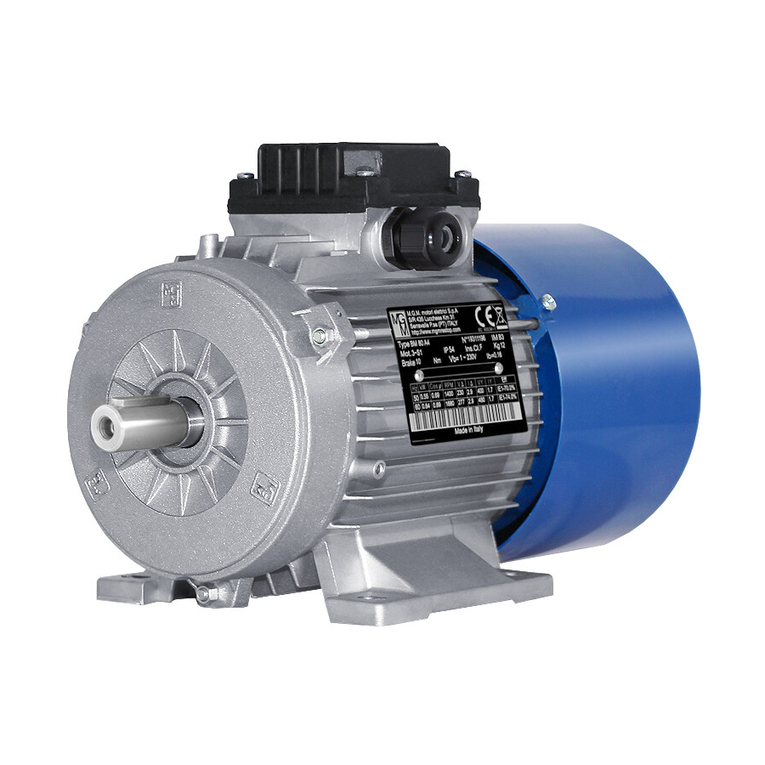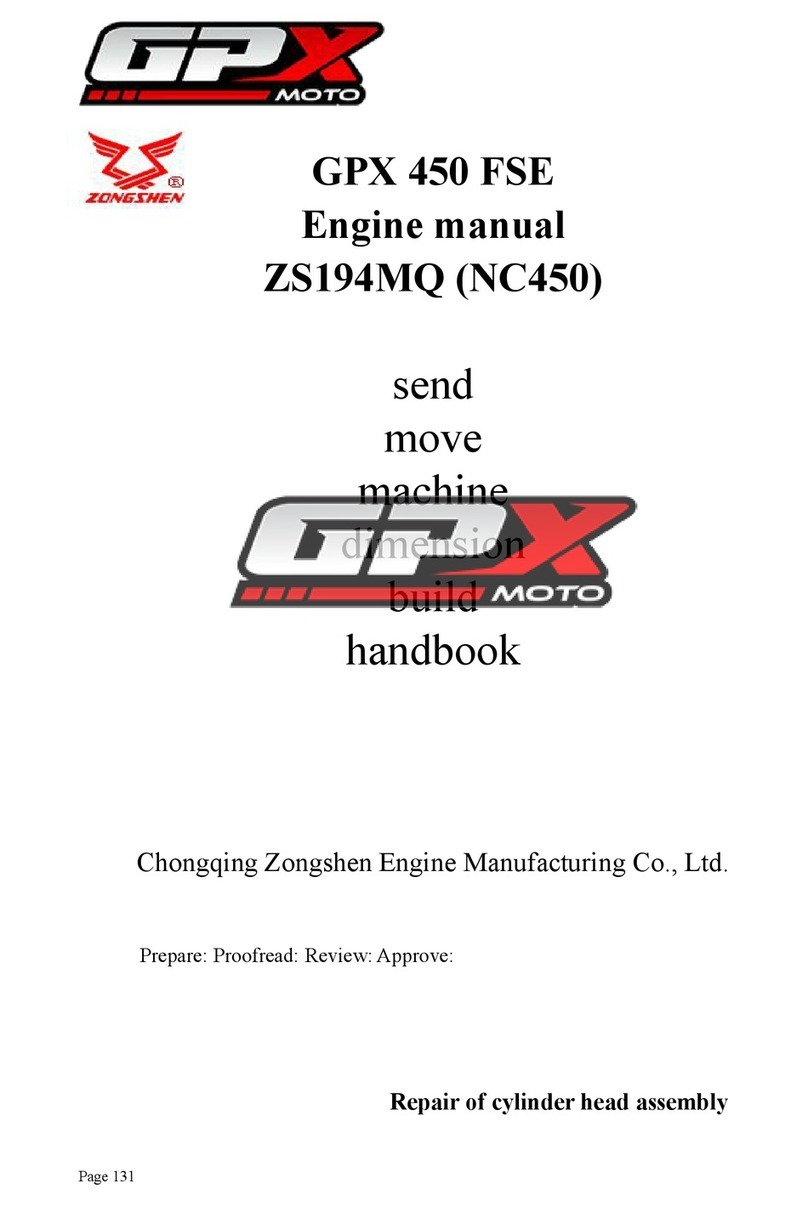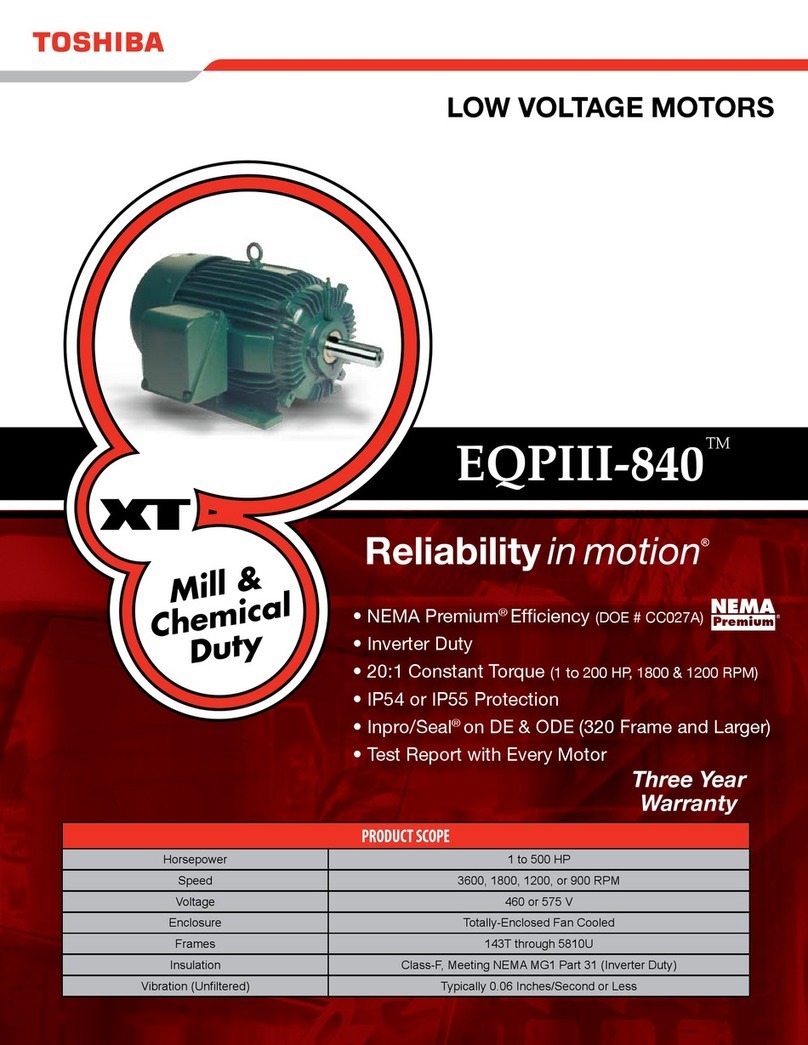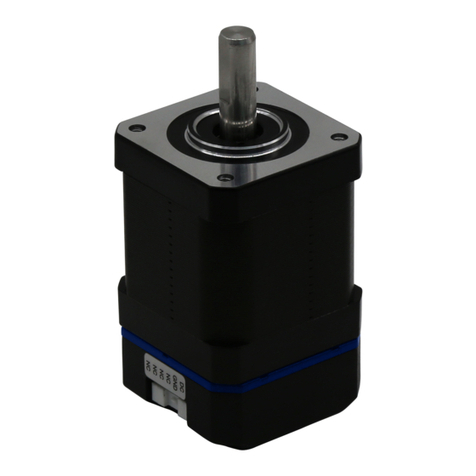MGM BA Series User guide

SERIE BA
Uso e manutenzione
Use and maintenance
Bedien- und Wartungsanleitung
Empleo y mantenimiento
Emploi et entretien
STABILIMENTO DI PRODUZIONE
HEAD OFFICE AND PRODUCTION
S.R. 435 KM. 31 - 51030 SERRAVALLE PISTOIESE (PT)
TEL. +39 0573 91511 R.A. - FAX +39 0573 518138
E-MAIL: [email protected]
http://www.mgmrestop.com
STABILIMENTO DI PRODUZIONE
HEAD OFFICE AND PRODUCTION
9731, METROPOLITAN BLVD. EAST
MONTREAL, QUEBEC H1J 3C1 - CANADA
TEL. +1 (514) 355-4343 - FAX +1 (514) 355-5199
E-MAIL: [email protected]
http://www.mgmelectricmotors.com
M.G.M. motori elettrici S.p.A.
A11H1108
M.G.M. ELECTRIC MOTORS NORTH AMERICA INC.
M.G.M. MOTORI ELETTRICI S.P.A.
DEPOSITO NORD-ITALIA:
NORTH ITALY BRANCH OFFICE:
VIA FERMI, 44 - 20090 ASSAGO - MILANO
TEL. +39 02 48843593 - FAX +39 02 48842837

ITALIANO
Vi ringraziamo per la fiducia accordataci acquistando questo prodotto. Prima di mettere in funzione il motore Vi
raccomandiamo di leggere attentamente queste istruzioni per assicurarVi di utilizzare il motore M.G.M. in condizioni di
sicurezzaealmassimodellesueprestazioni.
Per le varie tipologie di motori MGM si consiglia di prendere visione delle istruzioni d’uso e manutenzione nella
versione più completa e aggiornata sul nostro sito web (www.mgmrestop.com). Per qualsiasi difficoltà Vi preghiamo di
contattarel’organizzazionedellaM.G.M.specificandotipodiprodottoenumerodimatricola.
Queste istruzioni sono valide per tutti i motori elettrici M.G.M. appartenenti alla serie BA(BA, BAF, BAPV, BAMP, BAE,
BASV). La serie BA è costituita da motori elettrici autofrenanti asincroni trifase o monofase con costruzione chiusa e
ventilazione esterna. Il freno interviene in assenza di alimentazione. I motori della serie BA sono destinati ad essere
utilizzati come componenti in applicazioni industriali. Le prestazioni e le caratteristiche riportate sulla targa del motore
sono garantite per installazioni in ambienti con temperatura compresa tra –15°C a +40°C e altitudine inferiore a 1000
metris.l.m.Perognichiarimentocontattarel’organizzazionedellaM.G.M.MotorielettriciS.p.A.
Il motore riporta in targa la marcatura CE per attestare la conformità del prodotto alle direttive 2006/95/CE “Bassa
tensione”e2004/108/CE“Compatibilitàelettromagnetica”.
Durante il funzionamento i motori presentano parti sotto tensione o in movimento. La rimozione
delle necessarie protezioni elettriche e meccaniche, l'uso improprio o la non adeguata
manutenzionepossonocausaregravidanniapersoneecose.
Le operazioni di installazione, manutenzione, regolazione, sostituzione di componenti devono
essere fatte da personale qualificato utilizzando strumenti di lavoro adeguati, avendo
preventivamente verificato che il motore o l'impianto sia scollegato dalla rete di alimentazione e
chesuiterminaliinmorsettieranonsiapresentetensioneresidua.
Per la possibile mancanza di efficienza del freno durante le operazioni di regolazione,
manutenzione o sostituzione di componenti, verificare che all'albero motore non sia applicato
nessuncaricoprimadiogniintervento.
È necessario evitare il contatto con la superficie del motore dal momento che durante il
funzionamentolatemperaturapuòsuperarei50°C.
All'atto del ricevimento verificare che le caratteristiche riportate sulla targa del motore coincidano con quanto richiesto
echeilmotorenonabbiasubitodannidurante il trasporto; eventuali danni dovranno essere immediatamente segnalati
altrasportatore.
I golfari se presenti servono al sollevamento del solo motore e non di altre macchine ad esso
accoppiate.
Immagazzinareimotoriinluogoasciuttoeprivodipolvere.
L’installazione del motore deve essere fatta da personale qualificato utilizzando strumenti e mezzi di lavoro adeguati.
All’atto dell’installazione verificare che le caratteristiche richieste dal motore coincidano con quanto riportato sulla
targaconparticolareriguardoallatensionedialimentazioneeallacoppiafrenantemassima.
MarcaturaCE
Informazionigeneralisullasicurezza
Ricevimentoemagazzinaggio
Installazione

Verificare che il tipo di freno installato sul motore sia idoneo per l'applicazione prevista e che sia
conformeaeventualinormeeprescrizionivigenti.
Verificare che per il tipo di applicazione previsto sia necessario utilizzare un motore della serie -K
o -PK (ad esempio sollevamenti, impieghi di sicurezza, carroponte, etc).. Per eventuali
chiarimenticontattarelaMGMmotorielettriciSpa.
La serie BAnon comprende motori idonei ad essere utilizzati in ambienti con pericolo di esplosione. L'uso di un motore
nonidoneoinunambienteconpericolodiesplosionepuòcausaregravidanniapersoneecose.
Verificarechelacoppiafrenanteregistratasiaadeguataperl’applicazioneprevista.
Verificare che le guarnizioni siano in perfette condizioni e perfettamente alloggiate nelle loro sedi, che le aperture
d’ingressocavosianobenchiuseechesiagarantitoilgradodiprotezioneindicatointarga.
Perinstallazioni all’aperto, si raccomanda di proteggere opportunamente il motore dall’irraggiamentoe dalle intemperie.
E’opportuno evitare che i bocchettoni per l’ingresso dei cavi siano posizionati verso l'alto. Si consiglia inoltre che i cavi di
collegamento arrivino dal basso verso l’alto, per evitare fenomeni di gocciolamento o ristagno dell’acqua. Nel caso di
montaggio verticale con lato comando in basso è necessario l'uso della cuffia anti pioggia. Nel caso in cui siano rimossi i
golfari, se presenti, è necessario per garantire il grado di protezione IP, che siano sostituiti con viti di medesimo passo e
lunghezza.
Verificare prima della messa in servizio o dopo lunghi periodi di inattività o giacenza in magazzino che la resistenza di
isolamento verso massa non sia inferiore a 25MW(la misura deve essere fatta con strumento Megger 500 volts cc).
Non toccare i morsetti durante e negli istanti successivi alla misurazione in quanto i morsetti sono sotto
tensione.
Il motore deve essere installato in un locale aerato lontano da fonti di calore e in posizione tale da consentire la libera
aspirazione dell’aria per una corretta ventilazione. Il motore deve essere collocato in modo da consentire agevoli
operazioni di ispezione e manutenzione tenendo conto di eventuali pericoli derivanti dal contatto con parti in movimento
oconpartidelmotorechepossonosuperarei50°C.
L'equilibraturadeimotorièstatarealizzataconmezzachiavettaapplicataall'estremitàd'albero(EN60034-14).
All’atto del montaggio verificare che il motore e la macchina accoppiate siano allineate accuratamente in quanto un
allineamento impreciso può causare vibrazioni, danneggiamento dei cuscinetti e rottura dell’estremità d’albero. In
particolare all’atto del montaggio verificare, nel caso di motori con forma costruttiva IMB5 e IMB14, che le superfici di
accoppiamento siano ben pulite e che il centraggio sia perfetto. Per motori IMB3 verificare, nel caso di accoppiamento
con giunti, che l’asse del motore e della macchina condotta coincidano e, che, nel caso in cui si effettui l’accoppiamento
con pulegge, la tensione delle cinghie non sia eccessiva. La superficie alla quale viene fissato il motore deve garantire
stabilità di fissaggio, allineamento del motore con la macchina ad esso collegato, assenza di vibrazioni indotte sul
motorestesso.
E’necessarioprovvedereaffinchésia minimizzata la trasmissione di vibrazioni al motore.
Le attività di manutenzione devono essere eseguite da personale qualificato solo dopo aver preventivamente
scollegato l'impianto o il motore dalla rete (compreso eventuali ausiliari e in particolare le scaldiglie
anticondensa) e aververificato che all'albero motore non risultiapplicato nessun carico.
Manutenzione
Le attività di manutenzione devono essere svolte solo da personale qualificato e solo
dopo aver scollegato l'impianto o il motore dalla rete di alimentazione elettrica. La
carenza di ispezioni e manutenzione può causare gravi danni a persone o cose.
Le attività di ispezione e manutenzione di seguito descritte sono indispensabili
comunque,ma diventano particolarmente importanti per tutte le applicazioni gravose o
nelle quali il motore riveste una funzione di sicurezza (ad esempio sollevamenti, impieghi
di sicurezza, carroponte, etc.).

Per motivi di sicurezza la vite di sblocco del freno e la chiave a "T" non devono essere mai lasciate inserite sul
motore ma rimosse e custodite dal responsabile della manutenzione dell'impianto dopo ogni intervento. La
chiave a “T“deve essere utilizzata soltanto quando il motore è scollegato dalla rete di alimentazione e solo dopo
aver verificato cheall’albero motore non risulti applicato nessuncarico.
Dopo ogni intervento sul gruppo freno verificare sempre la chiusura della cuffia (26) attraverso un adeguato
serraggio della viteTE (27).
Di seguito sono elencate le attività che devono essere svolte periodicamente per assicurare il corretto funzionamento del
motore autofrenante MGM. La frequenza delle ispezioni dipende dalla particolare applicazione del motore (numero di
avviamenti, momento di inerzia applicato, condizioni ambientali etc.). Si consiglia di effettuare le prime ispezioni a
distanza di alcune settimane di funzionamento e di redigere conseguentemente un programma di manutenzione
periodica. Si raccomanda comunque di programmare le ispezioni successive con frequenza non inferiore a 2
volte all'anno. Pereventuali informazioni contattare l'organizzazione della M.G.M.motori elettrici S.p.A.
- Verificare periodicamente che il motore funzioni correttamente senza rumori o vibrazioni anomale e che le aperture per
ilpassaggiodell'ariaperlaventilazionenonsianoostruite.
-Verificareilcorrettoserraggiodeicavidialimentazionedelmotoreedelfrenoedelconduttorediterra.
- Verificare che, per effetto dell'usura della guarnizione di attrito del disco freno, il traferro non sia al di fuori dei
valori indicati nella tabella 1.
Si consideri che l'usura è maggiore durante la fase di rodaggio. Per la regolazione del
traferroseguireleindicazioniriportatenelparagrafo"RegolazionedelTraferro".
- Verificare lo stato di usura della superficie di attrito da entrambe le parti del disco freno (per i motori serie BAPV
da una sola parte) assicurandosi che lo spessore non scenda al di sotto di 2 mm. Verificare inoltre l'assenza di
danneggiamenti sulla superficie del disco ed in particolare nella dentatura del mozzo. (Per l'eventuale sostituzione
consultare il paragrafo "Sostituzione del Disco Freno"). Per i dischi con pista di attrito rivettata verificare che la superficie
frenante non abbia raggiunto il livello dei rivetti; verificare inoltre che non ci sia gioco tra il mozzo e il disco in
corrispondenzadeichiodi.
- Verificare periodicamente che la coppia frenante sia adeguata. Se necessario procedere alla regolazione secondo
quantoindicatonelparagrafo'Regolazionecoppiafrenante'.
- Verificare periodicamente lo stato di usura delle colonnette di guida (19-42) e il loro saldo ancoraggio sul convogliatore
(17).
- Tutti i componenti del gruppo freno e in particolare il disco freno (23, 39-41 per BAF, 45 per BAPV) e le
colonnette di guida (19, 42 per BAF-BAPV) sono componenti soggetti ad usura. In considerazione della
funzione di sicurezza svolta è necessario effettuare, come manutenzione preventiva, la sostituzione periodica.
La frequenza dipende dal tipo di lavoro svolto dal motore (numero di avviamenti, momento di inerzia applicato,
condizioni ambientali etc.); si raccomanda comunque di provvedere alla sostituzione con una frequenza non
superioreai18mesi.
- Verificare periodicamente lo stato di usura della dentatura dell'albero dove scorre il disco freno. Se la
dentaturapresentaun'usuravisibileènecessarioprovvedereallasostituzionedell'alberorotore(1).
La coppia frenante è proporzionale alla compressione delle molle (18) che può essere variata agendo sui dadi (20). Nella
tabella2e3sonoriportatiivaloridicompressionestandard(Hstd)dellemolle.
La coppia frenante corrispondente alla regolazione standard della compressione delle molle riportata in tabella, è
solitamente inferiore a quella massima riportata sulla targa del motore, soprattutto per i gruppi freno con elettromagnete
AC. Dopo aver effettuato la registrazione verificare sempre che la coppia frenante sia idonea per l'utilizzo previsto. Se
alimentando il freno l'elettromagnete non riuscisse a richiamare l'ancora mobile (24) con un colpo secco e a tenerla
attrattasenzavibrazioni, verificare l'esatta regolazione del traferro (60) e, se l'inconveniente persiste, allentare i dadi (20)
eriprovaresinoadottenereilfunzionamentocorretto.
Per motori che possono essere provvisti di 3 oppure 6 molle (serie BA 160÷225) porre attenzione alla diversa
regolazionedellacompressionedellemollenecessariaperilraggiungimentodellacoppiafrenantedesiderata.
Verificaresempreafineinterventochelacoppiafrenanteregistratasiaadeguata.
Il traferro deve rimanere entro i valori indicati in tabella per evitare possibili
danneggiamenti del gruppo freno.
RegolazioneCoppiaFrenante

Non superare mai il valore di coppia frenante massimo riportato in targa. Si consiglia di evitare di regolare la coppia
frenanteavalori inferiorial30%delvaloremassimo.
Verificare che il disco freno sia del tipo idoneo per l'applicazione prevista e in particolare verificare se sia necessario
utilizzare un disco freno K (ad esempio sollevamenti, impieghi di sicurezza, carroponte etc.). Per eventuali chiarimenti
contattare la MGM motori elettrici Spa. Svitare la vite T.E. (27), togliere la cuffia (26) e svitare i dadi (22), sfilare
l’elettromagnete (25) dalle colonnette (19), togliere i dadi (20-21) e le molle (18). Estrarre l’ancora mobile (24) dalle
colonnette (19), togliere il disco freno (23) vecchio ed inserire il disco nuovo. Porre attenzione che il disco sia inserito nel
verso corretto. Procedere a ritroso per il successivo montaggio. Si raccomanda di maneggiare il disco freno con le mani
puliteperchéognitracciadigrassodiminuiscelacapacitàfrenanteeaumentalarumorosità.
Nei motori BAF rispetto alla versione BAci sono due dischi freno (39-41), con interposta l’ancora mobile ausiliaria (40).
Dopo aver montato l’elettromagnete (25) procedere alla regolazione del traferro. Per i motori della serie BAPV per la
sostituzionedeidischivolano(45)attenersialleistruzionispecifiche.
Prima di procedere alla sostituzione del disco verificare sempre lo stato di usura della dentatura dell'albero
dovescorre il disco freno. Se la dentatura presenta un'usura visibileè necessario provvedere alla sostituzione
dell'alberorotore(1).
Svitare la vite T.E. (27), togliere la cuffia (26), scollegare i connettori dell’elettromagnete (25), svitare i dadi (22) e sfilare
dalle colonnette (19) l’elettromagnete (25). Ricollocare sulle colonnette il nuovo elettromagnete e i dadi ed effettuare il
collegamento elettrico avendo cura di disporre i connettori nella posizione che rende possibile l’innesto. Prima di
rimontare la cuffia di protezione freno (26) verificare che i connettori e i relativi cavi siano ben ancorati. Procedere con la
regolazione del traferro (vedere relativo paragrafo). Verificare che l’elettromagnete funzioni regolarmente; alimentando
il freno l’elettromagnete (25) deve richiamare l’ancora mobile (24) con un colpo secco e tenerla attratta senza alcuna
vibrazione o rumorosità. Se l’ancora mobile (24) tendesse a vibrare occorre verificare che i terminali siano accoppiati
correttamente.
Svitare la vite T.E. (27), togliere la cuffia (26 o 48) e svitare i dadi (22), sfilare l’elettromagnete (25) dalle colonnette (19 o
42), togliere i dadi (20-21) e le molle (18). Estrarre l’ancora mobile (24) dalle colonnette (19 o 42), svitare le colonnette
vecchie e avvitare le nuove verificando che siano saldamente ancorate al convogliatore (17). Dopo avere avvitato
ciascuna colonnetta (19 o 42) verificare che la base di appoggio della stessa sia completamente a contatto con la
superficiedelconvogliatore(17).
Il traferro (60), ossia la distanza tra i due nuclei elettromagnetici dell'elettromagnete (25) e dell'ancora mobile (24), deve
rimanere entro i valori indicati nella tabella 1. E' necessario non oltrepassare tali valori, per evitare vibrazioni dell'ancora
mobile, rumorosità eccessiva, l'eventuale bruciatura delle bobine dell'elettromagnete o il danneggiamento del gruppo
freno. Il traferro tende ad aumentare per effetto dell‘usura del disco freno. Si consideri che l'usura del disco freno è
maggiore durante la fase di rodaggio(alcune migliaia di frenate).
Per riportare il traferro al valore richiesto occorre agire sulle coppie di dadi (21-22) che fermano l'elettromagnete (25)
facendolo avanzare verso l'ancora mobile (24). Non è corretto serrare i dadi (22) di blocco dell'elettromagnete su una
delle colonnette prima di aver ultimato la regolazione della posizione dell'elettromagnete su tutte le colonnette. Non si
deve pertanto modificare la posizione dell'elettromagnete agendo su un dado interno (21), per fare una regolazione in
corrispondenza di una colonnetta, se non sono stati allentati precedentemente i dadi esterni (22) su tutte le colonnette. Il
traferro deve essere uniforme allo scopo di garantire il corretto funzionamento ed evitare sollecitazioni meccaniche
dovute al cattivo allineamento. Per gruppi freno con 6 colonnette (19-42) effettuare inizialmente la regolazione della
posizione dell'elettromagnete (agendo sui dadi 21-22) solo su 3 colonnette poste a 120°. Dopo aver registrato il traferro
sulle prime 3 colonnette completare l'operazione sulle rimanenti 3 colonnette accostando prima i 3 dadi (21) a contatto
con l'elettromagnete e serrando quindi i 3 dadi (22). Ad operazione conclusa verificare l'uniformità del traferro e il
serraggiodeidadi(21-22).
SostituzionedelDiscoFreno
Sostituzionedell’Elettromagnete
Sostituzionecolonnette
RegolazionedelTraferro

We would like to thank you for trusting us and buying our product. Before starting the motor, we advise you to read these
instructions carefully, to be sure that the M.G.M. motor is used in safe conditions and to obtain its highest performance.
For the different MGM motors types we suggest to download the “Use and maintenance” in its last and complete version
directly from our web site: www.mgmrestop.com. Should any difficulty arise, please contact the M.G.M. organization,
specifyingthetypeofproductanditsserialnumber.
These instructions are valid for all M.G.M. electric motors belonging to the BA series (BA, BAF, BAPV, BAMP, BAE,
BASV). The BA series includes asynchronous three-phase or single-phase totally enclosed fan cooled brake motors.
The motors brake in case of power supply failure. The BA motors series are used as components in industrial
applications. Performance and characteristics shown on the motor nameplate are guaranteed for installations in
ambients having a temperature range of –15°C to +40°C and at an altitude less than 1000 meters above sea level. For
anyclarifications,pleasecontacttheM.G.M.motorielettriciS.p.A.organization.
The motor shows on its nameplate the CE mark to attest the conformity of the product to the 2006/95/CE “Low voltage”
directiveand2004/108/CE“Electromagneticcompatibility”directive
Duringoperation, motors have live or moving parts. Therefore, removal of electrical or mechanical
guards, improper use, or inadequate maintenance may cause serious damage to persons or
property.
Installation, Maintenance, Adjustment, Replacement operations of components must be carried
outby qualified personnel, using proper tools and working instruments.Above all, itisessential to
verify that motor or plant are disconnected from the supply line and that on board terminals there
isnovoltageleft.
In case of uneffective braking during regulation, maintenance or replacement operations of
components,checkthatnoloadisappliedtothedriveshaft.
Avoid contact with the motor case since the temperature under normal operating conditions may
exceed50°C
Whenreceivingthemotor,it is essential to check that:
-allthecharacteristicsshownonthemotornameplatecorrespondto the requested ones;
-themotorhasnotbeendamagedduringtransportation;anydamagemustbepointedouttothecarrierimmediately.
Theringbolts,ifanymustbeusedtoliftonlythemotorwithoutanyothermachinesfittedtoit.
Themotorsmustbestoredinasheltered,dryanddust-freeplace.
The installation of the motor must be carried out by qualified personnel, using proper tools and working instruments.
When the installation is started, be sure that the characteristics expected from the motor match what is shown on the
motornameplate,whithparticularattentiontothesupplyvoltageandtothemaximumbrakingtorque.
Makesurethatthe braking torque shown is suitableforthedesired application.
Please verify that the type of brake is suitable for the application and in compliance with standards
orrulesinforce on the machine on whichthemotoris incorporated.
Verify that for the application requirements isneedtobeusedamotorofˆKorˆPKseries(e.g.lifting,
safetyapplications, cranesandso on). For further details plscontactMGMmotori elettrici SpA.
CEMark
Generalsafetyinformation
ReceiptandStorage
Installation
ENGLISH

BA series doesn't include motors suitable for hazardous environment. Misapplication of a motor in hazardous
environmentcancausefireoranexplosionandresultinseriousinjury.
Check that all the gaskets are in perfect conditiion and well seated in their places; check that the cable inlet openings are
properlyclosedandtheIPprotection level shown on the plate is respected.
For outdoor installations, it’s recommended to protect the motor against the sun irradiation and against bad weather
conditions. For outdoor vertical mounting with shaft down it is necessary to use a rain proof cover. Pls check that the
cables entry isn’t on the top of the terminal box. We suggest in any case that the connection cables come from the
bottomupwardsinordertoavoiddripandwaterstagnation.
The ringbolts if removed must be replaced with screws with the same length and pitch to guarantee the IP protection
degree.
Before starting the motor or after long periods of inactivity or storage, check that the earth insulation resistance is not
lessthan25MW(themeasuringmustbedonewitha500VDCMeggerinstrument).
Never touch the terminals during and immediately after measurement since they may carry dangerous
voltages.
The motor must be installed in a ventilated room away from heat sources and in such a position to allow free air intake for
proper ventilation. The motor must be also mounted in such a place as to allow easy inspection and servicing
operations, keeping in mind possible danger arising from touching moving parts or the motor frame which may exceed
50°C. The motor is balanced with half key fitted (60034-14). During the mounting stage, check that motor and machine
coupling is accurately aligned, as an imperfect alignment could cause vibrations, damage the bearings, or cause shaft
end breakage. In particular, when IMB5 and IMB14 construction motors are used, check that coupling surfaces are
thoroughly cleaned and that the centering is perfect during the mounting stage. For IMB3 motors, when using couplings
withjoints, check that the motor axis and the driven machine axisare perfectly in line. When using pulleys, check that the
belt tension is not too high. The surface where the motor is anchored must insure stability of fixing, motor alignment to
the connected machine, lack of vibrations transmitted to the motor itself. So pls verify that no vibrations are transmitted
tothemotor.
Maintenance operations must be carried out by qualified personnel and only after having disconnected the
plant or the motor from the electrical supply (including any possible auxiliaries and especially anti-
condensation heaters) and after having checked that no load is applied to the driveshaft. For security reasons
the hand release (49) and the hexagonal "T" key (51) never must be fitted on the motor but removed and kept by
the plant maintenance responsible after every intervention. The hexagonal “T” key must be used only after
having disconnected the motor from the electrical supply and after having checked that no load is applied to
the drive shaft.After any operation on brake assembly, verify that the end protection cover (26) is firmly held in
placebythehexagonalrearnut(27).
The operations which must be carried out periodically in order to ensure the correct functioning of the MGM brake motor
are listed further on. The frequency of inspection depends on the particular motor duty ( number of start/stop, applied
moment of inertia, environment conditions and so on). Generally it's advisable to proceed to the first inspection
after few weeks of working and to draw up a periodical maintenance plan.Anyway it's recommended to provide
Maintenance
Maintenance operations must be carried out only by qualified personnel and only
after having disconnected the plant or the motors from the electrical supply.
Inadequate inspections and maintenance can produce personal injury or
property damage.
Maintenance and inspection operations described here below are absolutely
essential in any case and they become even more important in relation to heavy
duty applications or situations in which the brake motor performs as key safety
role (e.g. Lifting, safety applications, cranes and so on).

inspections at least twice a year. For specific information pls contact the M.G.M. motori elettrici S.p.A.
organization.
- Periodically check that the motor operates correctly without noise or strange vibrations and that the openings for
ventilationarenotobstructed.
- Verify that all motor and brake supply terminals are property tightened to the terminal board as well as the earthing
terminaltothemotorframe.
-As a result of normal wear of the brake disc lining, check that the air gap does not exceed the values shown on
table 1.
Please note that the brake linings wear is greater during the run-in. ( few thousands stops). For the air gap
adjustment,followtheinstructionsgivenintotheparagraph"AirGapAdjustment".
- Check the wear on both friction surfaces of the brake disc (on one side only for BAPV series) to be sure that
their thickness is not less than 2 mm. Verify also that there are no damages on disc surfaces and, in particular, in the
hub toothing. (For replacement, refer to the paragraph "Brake Disc Replacement"). For those brake disc with rivets on
disc lining verify that braking surface has not reached the rivets; moreover check that no play should be between the
brakediscandthebrakedischubincorrespondenceofthehubnails.
- Verify periodically that the braking torque is suitable. If needed, proceed to its adjustment as stated in the paragraph
"Brakingtorqueadjustment".
- Verify regularly the brake adjuster (19-42) wear conditions and their steady fastening on the rear cover brake surface
(17).
- All brake assembly components, in particular the brake disc (23, 39-41 for BAF series, 45 for BAPV) and the
brake adjusters (19, 42 for BAF-BAPV series) are subject to wear. In consideration of safety it's needed to
replace them periodically. The replacement frequency comes from the motor duty (number of start/stop,
applied moment of inertia, environment conditions and so on), we recommend however to replace them at
leastevery18months.
- Periodically check and verify the shaft splines wear, exactly where the disc slides. If the shaft splines has a
visiblewearit'snecessarytoreplacetherotorshaft(1).
The brake torque is proportional to the spring (18) compression. The compression of the springs must be as uniform as
possible. On the table 2 and 3 are shown the standard compression values (H std) of the brake springs. The
corresponding brake torque of the standard compression values stated on the table are less than the maximum braking
torque stated on the motor nameplate, especially for AC brake assembly. Please verify that the braking torque is
suitableforyourapplication.
If the brake coil (25) isn't able to call the brake moving element (24) back with a quick stroke and keep it attracted without
vibrations, verify the exact air gap adjustment and, if this inconvenience still persists, loosen the locknut (20) and try it
againuntildesiredfunctioningisobtained.
Some types of motors ( BAseries 160÷225) can have 3 or 6 springs(18). Pay attention to the different adjustment of the
springcompressiontoreachthebraketorquevaluerequired.
Aftereveryinterventionplsverifythatthebrakingtorqueisthatrequired.
Never exceed the maximum braking torque value stated on the motor name plate. It's recommended to avoid adjusting
thebrakingtorquetovalueslowerthan30%ofthemaximumvalue.
Please verify that the type of brake disc is suitable for the application and in particular verify if it's need to be used a K
brakedisc(e.g.liftings,safetyapplications, cranes and so on). For further details pls contact MGM motori elettrici SpA.
Loosen the rear nut (27), remove the end cover (26) and unscrew the locknuts (22). Take off the brake coil (25) from the
brake adjusters (19), remove the nuts (20-21) and the springs (18). Remove the brake moving element (24) sliding it
through the brake adjusters (19). Take off the old brake disc (23) and put in the new one.Verify that the new brake disc
has been placed in the correct side. For re-assembling, proceed backwards. We recommend that the new brake disc
must be handled with clean hands, because even a small trace of grease will decrease the braking performance and
also increase noise. In the BAF series otherwise than in the BA series there are 2 brake discs (39-41) with an
intermediate brake moving element (40) in between. After the brake coil (25) replacement, proceed to the airgap
The airgap must be as indicated on the table. Don’t exceed this range to avoid any damage on the brake
assembly.
BrakingTorqueAdjustment
BrakeDiscReplacement

adjustment (see the pertinent paragraph). For the flywheel (45) replacement on the BAPV series, follow up the specific
instructions.
Before replacing the brake disc it's always necessary to check the shaft splines wear, exactly where the disc
slides.Iftheshaftsplineshasavisiblewearit'snecessarytoreplacetherotorshaft(1).
Loosen the rear nut (27), remove the end cover (26), disconnect the brake coil (25). Unscrew the locknuts (22) and pull
off the brake coil (25) from brake adjusters (19). Reassemble the new brake coil on the brake adjusters (19) and
reconnect the electrical connectors. Pay attention to place the electrical connectors in the right position so that to allow
their insertion. Before reassemble the end cover (26) and the nuts verify that the connections and relative cables are
property tightened. Proceed with the air gap adjustement as stated in the respective paragraph. Verify that the brake coil
functions correctly; when the brake is energized, the brake coil (25) should attract the brake moving element (24) with a
quick stroke, and hold it without any vibration or noise. In case of any vibration, check that terminal connectors are
coupledcorrectlyandtightly.
Loosenthe rear nut (27), remove the end cover (26 or 48) and unscrew thelocknuts(22).Takeoffthe brake coil (25)from
the brake adjusters (19 or 42), remove the nuts (20-21) and the springs (18). Remove the brake moving element (24)
sliding it through the brake adjusters (19), remove the old brake adjusters and screw the new ones verifying their steady
fastening on the rear cover brake surface (17). After having screwed each brake adjuster (19 or 42) it's necessary to
checkthatitssupportbottomiscompletelyleanedontherearcoverbrakesurface(17).
The air gap (60) i.e. the distance between the two magnetic cores of the brake coil (25) and the brake moving element
(24), must be as shown on table 1. It's strongly unadvisable to exceed these values in order to avoid vibrations of the
brakemovingelement,prominentnoise,theburningofthebrakecoilorthebrakeassemblydamaging.
It's advisable to check periodically the air gap, because by the wear of the brake disc linings, it tends to increase. Please
notethatbrakeliningswearisgreaterduringtherun-in(fewthousandsstops).
In order to set the airgap back to the required value, operate on the nuts (21-22) to obtain the brake coil forward
displacement towards the brake moving element (24). It's strongly recommended to avoid to tighten the locknut (22)
located on one brake adjuster (19, 42 for BAPV-BAF series motors) before having completed the positioning of the
brake coil (25) on all the brake adjusters. Therefore don't regulate the position of the brake coil adjusting the nut (21) on
one brake adjuster, if previously you didn't loose the locknuts (22) on all the brake adjusters (19, 42 for BAPV-BAF series
motors). This wrong operation could stress the air gap adjusters. Please verify that the airgap is uniform. The air gap
must be uniform to guarantee the right working and avoid mechanical stresses due to a wrong allignment. When the air
gap adjustment has been settled, the locknuts (22) should be tightened. For brake assembly with 6 brake adjusters (19,
42forBAPV-BAF series motors), as first step regulate the brake coil position only on three brake adjusters at 120° by the
nuts 21-22.After having adjusted the position on these 3 brake adjusters, to complete the operation go on with the other
3 brake adjusters and first bring the air gap adjusting nuts (21) close to the brake coil and then tighten the locknuts (22).
Whentheoperationhasbeensettled,verifythattheairgapisuniformandthenuts(21-22)aretightened.
BrakeCollReplacement
AirGapAdjustment
Brakeadjustersreplacement

Wir danken Ihnen für Ihr Vertrauen beim Kauf dieses Produktes. Lesen Sie bitte vor Inbetriebnahme des Motors
aufmerksam die vorliegende Anleitung durch, damit sichere Betriebsbedingungen und maximale Leistung für den
M.G.M.Motorgewährleistetsind.
Sollten Schwierigkeiten jeglicher Art auftreten, setzen Sie sich bitte mit dem M.G.M. - Stammhaus in Verbindung und
geben Sie die Typenbezeichnung und die Kennummer Ihres Motors an. Zusätzliche Informationen zu den
verschiedenenAusführungen undAnwendungsmöglichkeiten der MGM-Bremsmotoren, können in den ausführlicheren
Betriebs-undWartungsanleitungen auf unserer Website eingesehen werden (www.mgmrestop.com).
Die vorliegende Anleitung gilt für alle M.G.M. Elektromotoren der Baureihe BA (BA, BAF, BAPV, BAMP, BAE, BASV).
Die Baureihe besteht aus einphasigen und dreiphasigen asynchronen außenbelüfteten Bremsmotoren in
geschlossener Bauweise. Die Bremse wirkt im stromlosen Zustand. Die Motoren der Baureihe BA werden als Bauteile
in Industrieanlagen eingesetzt. Die Leistungsangaben auf dem Typenschild gelten bei einer Umgebungstemperatur
von 15 Grad bis +40 Grad und auf einerAufstellungshöhe bis zu 1000m über Meeresspiegel. Für weitere Fragen setzen
SiesichbittemitdemM.G.M. StammhausinVerbindung.
Das auf dem Typenschild des Motors angebrachte CE - Zeichen bestätigt, dass das Produkt gemäß den folgenden
Richtlinien hergestellt ist: Richtlinien 2006/95/CE ''Nieder-Spannung“, Richtlinien 2004/108/CE‚ "Elektromagnetische
Verträglichkeit“.
Wenn eingeschaltet, setzten die Motoren Teile unter Spannung oder in Bewegung. DasAbnehmen
elektrischer und mechanischer Schutzteile sowie die nicht angemessene Wartung können
SchädenanPersonenundGegenständeverursachen.
Die Aufstellung, Wartung, Regelung sowie der Austausch von Bauteilen muss jeweils durch
qualifiziertes Fachpersonal unter Einsatz geeigneter Arbeitsmittel und Geräte erfolgen, wobei
gewährleistet werden muss, dass der Motor oder die Anlage vom Stromnetz abgeschaltet ist bzw.
andenjeweiligenAnschlüssenamKlemmbrettkeineRestspannunganliegt.
Zur Vermeidung von Funktionsstörungen der Bremse während der Regelung, Wartung oder
Auswechslung von Bauteilen, muss sichergestellt werden, dass dieAntriebswelle vorAusführung
derjeweiligenMaßnahmenbelastetist.
Vermeiden Sie bitte den Kontakt mit dem Motor, da während der Inbetriebnahme Temperaturen
über50°Cerreichtwerden.
BeiderÜbernahmedesMotorsistfolgendeszuprüfen:
-oballeaufdemTypenschild angegebenen technischen Daten denAnforderungenentsprechen;
- ob der Motor beim Transport einen Schaden erlitten hat. Eventuelle Beschädigungen müssen unverzüglich dem
Spediteurgemeldetwerden.
Die Ösenschrauben, wenn vorhanden, dienen ausschließlich zur Anhebung des Motors und nicht
vonanderenanihmverbundenenMaschinenoderAnlagen.
DieMotorenmüssenineinemtrockenenundstaubfreienRaumgelagertwerden.
Der Motor muss von qualifiziertem Fachpersonal unter Verwendung geeigneter Werkzeuge und Geräte angeschlossen
werden. BeimAnschluss überprüfen, ob die für den Einsatz notwendigen Daten mit denAngaben auf dem Typenschild
übereinstimmen, mit besonderen Aufmerksamkeit auf die Versorgungsspannung und auf das maximale
Bremsmoment.
CE-Kennzeichnungen
AllgemeineInformationenzumThemaSicherheit
UbernahmeundLagerung
Installation
DEUTSCH

Es ist außerdem zu prüfen dass die Bremseinheit für die vorgesehene Anwendung geeignet und
konform mit den aktuellen Richtlinien ist. Bitte überprüfen, dass für den Anwendungsfall, die
Motoren der Serie K oder PK verwendet werden (z. B. Abhebungen, Sicherheitsanwendungen,
Laufkran,etc.).
Die Motoren der Baureihe BAsind nicht für den Betriebseinsatz in explosionsgefährdeten Umgebungen geeignet. Der
Einsatz dieser Motoren in explosionsgefährdeten Bereichen kann zu erheblichen Personenschäden und
Sachbeschädigungenführen
Esistzuüberprüfen,obdaseingestellteBremsmomentdenvorgesehenenBetriebsbedingungenentspricht.
Den einwandfreien Zustand und den korrekten Sitz der Dichtungen überprüfen. Kontrollieren, ob die PG-
Verschraubungen gut verschlossen sind und ob der auf dem Typenschild angegebene Schutzgrad gewährleistet ist.
Bei Betriebseinsatz im Freien empfiehlt es sich, den Motor von Umwelt- und Witterungseinflüssen zu schützen.
Gleichzeitig sollte man vermeiden, die Kabeleinführungsschrauben nach oben auszurichten, und man sollte darauf
achten, dass die angeschlossenen Stromleitungen von unten nach oben geführt werden, damit kein Rücklauf- oder
Tropfwasser in den Klemmkasten eindringen kann.
Prüfen Sie, ob die auf dem Typenschild angegebene IP-Schutzart, für die vorgesehene Anwendung geeignet ist. Bei
vertikalem Betriebseinsatz mit der Motorwelle nach unten, ist es erforderlich eine Regenschutzhaube zu verwenden.
Vor Inbetriebnahme oder nach langen Stand bzw. Lagerungszeiten sicherstellen, dass der Isolierwiderstand gegen
Masse nicht unter 25MWliegt (die Messung muss mit einem Messerinstrument 500V DC durchgeführt werden).
Niemals die Klemmen während und unmittelbarnach der Messung berühren, da an ihnen Strom anliegt. Der
Motor muss in einem belüfteten Raum fern von Wärmequellen installiert werden. Die Position des Motors ist so zu
wählen,dassdieLuftungehindertangesaugtwerdenkann,umeineguteBelüftungsicherzustellen.
Der Motor muss so aufgestellt werden, dass genug Raum zur problemlosen Durchführung von Inspektions- und
Wartungsarbeiten bleibt, hierbei sind eventuelle Gefahren durchdenKontaktmit beweglichenTeilenodermitTeilendes
Motors, die Temperaturen über 50 Grad erreichen können, zu berücksichtigen. Bei der Montage sicherstellen, dass der
Motor und die angeschlossene Maschine korrekt ausgerichtet sind. Eine ungenaue. Die Auswuchtung der Motoren
wurdedurchdieAnbringung einer halben Passfeder an der Welle ausgeführt(EN60034-14).
Ausrichtung kann zu Vibrationen, Lagerschäden, und Brüchen am Wellenende führen. Insbesondere ist bei der
Montage von Motoren in den Bauformen IMB5 und IMB14 sicherzustellen, dass die Verbindungsflächen sauber und
perfekt zentriert sind. Im Falle von IMB3-Motoren mit Verbindung über eine Kupplung kontrollieren, dass die
Motorachse mit der Achse der angeschlossenen Maschine fluchtet; im Falle einer Verbindung über Riemenscheiben
sicherstellen, dass die Riemen nicht zu straff gespannt sind. Die Befestigungsfläche an die der Motor montiert wird,
muss eine ausreichende Stabilität gewährleisten und die Motorwelle muss absolut fluchtend ausgerichtet mit der
Maschineverbundenwerden,sodasskeineVibrationenauftreten und übertragen werden können.
Sämtliche Wartungsarbeiten sind vom qualifizierten Fachpersonal auszuführen, nachdem die Anlage bzw.,
der Motor vom Stromnetz getrennt wurde (einschließlich eventueller Hilfsvorrichtungen und insbesondere der
Stillstandsheizung), und nachdem der Rotor im Ruhezustand ist. Aus Sicherheitsgründen muss die
Handlüftungsschraube der Bremse und der ''T“-förmige Imbus-Schlüssel vom Motor entfernt und vom
Wartungspersonal aufbewahrt werden. Der T-Schlüssel darf nur dann benutzt werden, wenn der Motor von der
Wartung
Wartungsarbeiten müssen vom Fachpersonal ausgeführt werden und nur dann,
wenn man sich vergewissert hat, dass der Motor vom Versorgungsnetz getrennt
worden ist. Die Nichteinhaltung der Wartungsarbeiten kann erhebliche Schäden
an Personen und Sachen verursachen.
Die unter geschriebene Inspektions- und Wartungstätigkeit ist ywar in jedem Fall
notwendig, sie wird aber besonders wichtig für alle hochbelastbaren
Anwendugen in denen der Motor eine Sicherheitsrolle (z. B. Abhebungen,
Sicherheitsanwendungen, Laufkran, etc.).

Stromversorgung getrennt worden und die Motorwelle nicht belastet ist. Bei der Endmontage darauf achten, dass
dieBremsbzw.Lüfterhaube(26)mitder6-kt.SchraubeTE (27) einen festen Montagesitz aufweist.
Im Folgenden werden die Arbeiten beschrieben, die regelmäßig durchzuführen sind, um die Betriebsfähigkeit des
Bremsmotors von M.G.M. sicherzustellen. Die Häufigkeit der Kontrollen hängt von den Einsalzbedingungen des
Motors ab (Umgebungsbedingungen, Anzahl der Startvorgänge, Massenträgheitsmoment usw.). Es empfiehlt
sich, die ersten Wartungen in kürzeren Abständen von einigen Wochen durchzuführen und diese anschließend
in regelmäßig wiederkehrenden Intervallen mindestens 2mal pro Jahr fortzuführen. Für alle weiteren
InformationensetzenSiesichbittemitdemM.G.M. StammhausinVerbindung.
- Regelmäßig kontrollieren, ob der Motor korrekt, d.h. ohne auffällige Geräusche und Vibrationen lauft, und ob die
LufteinlassgitterfürdieBelüftungnichtverstopftsind.
- Prüfen, ob die Versorgungskabel am Klemmenbrett des Motors und das Erdungskabel am Motorgehäuse
ordnungsgemäßbefestigtsind.
- Kontrollieren, ob infolge von Verschleißerscheinungen am Reibbelag der Bremsscheibe der Luftspalt nicht
außerhalb der Toleranzwerte der Tabelle 1 eingestellt ist.
Zur Einstellung des
LuftspaltsdieAnweisungenimAbschnitt''EinstellungdesLuftspalts“beachten.
- Den Verschleißzustand der Kontaktfläche auf beiden Seiten der Bremsscheibe kontrollieren (für die Motoren
der Baureihe BAPV nur auf einer Seite). Sicherstellen dass die Belagstärke mindestens 2 mm beträgt. Ferner
kontrollieren, ob keine sonstige Schäden auf der Bremsscheibenfläche und insbesondere in der Nabenverzahnung
sichtbar sind. (Ist eine Erneuerung der Bremsscheibe notwendig, die Anleitung im Abschnitt ''Austausch der
Bremsscheibe“ befolgen). Bei Bremsscheiben mit genieteten Bremsbeläge darauf achten, dass die Beläge nicht bis auf
HöhederNietenabgenutztsindunddasSpielzwischenBremsnabeundBremsscheibenbeidenNietenkontrollieren.
- In periodischen Zeitabständen muss das Bremsmoment überprüft werden. Falls erforderlich muss die Einstellung
gemäßdenAngaben imAbschnitt„ Bremsmomenteinstellung“ neu erfolgen.
- In Zeitabstände ist der Verschleiß der Führungsstifte (19-42) und deren Verankerung an der Bremsandruckplatte (17)
zuüberprüfen.
-Alle Einzelteile der Bremseinheit, insbesondere die Bremsscheibe (Teil 23, 39-41 für BAF, 45 für BAPV) und die
Führungsstifte (Teil 19, 42 für BAF-BAPV), sind Verschleißteile, die regelmäßig überprüft und in Abhängigkeit
der Sicherheitserfordernisse und des Betriebseinsatzes ausgetauscht werden müssen, um eine einwandfreie
Funktionzuermöglichen.DieseVerschleißteilesolltenspätestensalle18Monateausgetauschtwerden.
- Regelmäßig den Verschleiß der verzahnten Welle kontrollieren, über welche die Bremsscheibe läuft. Sollte die
Verzahnungstarkabgenutztsein,mussderRotor(1)ausgetauschtwerden.
Das Bremsmoment verhält sich proportional zum Druck der Federn (18), der durch das Verstellen der Muttern (20)
verändertwerdenkann.InderTabelle 2 und 3 sind die Standard Druckspannungswerte (H std) der Federn aufgeführt.
Das in der Tabelle eingetragene Standard-Bremsmoment ist geringfügig kleiner als das auf dem Leistungsschild
eingetrageneBremsmoment,besondersfürdieBremseinheitenmitAC-Bremse.
Nach der Einstellung sollte man immer prüfen, ob das Bremsmoment für den Verwendungszweck geeignet ist. Falls der
Elektromagnet bei Speisung der Bremse den beweglichen Anker nicht mit einem Schlag einzieht und diesen
schwingungsfrei festhält, muss die Einstellung des Luftspaltes (60) überprüft werden. Falls dieser Mangel weiterhin
auftritt, die Muttern (20) jeweils um zwei Gewindedrehungen lockern und erneut erproben, bis die Bremse
ordnungsgemäßfunktioniert.
Bei Motoren, die über 3 bis 6 Federn verfügen (Serie BA160÷225), sollte man auf die unterschiedliche Regulierung der
DruckspannungderFedernachten,damitdasgewünschteBremsmomenterreichtwird.
Prüfen Sie anschließend, ob das eingestellte Bremsmoment angemessen ist. Achten Sie darauf, dass das auf dem
Leistungsschildeingetragenemax.Bremsmomentnichtüberschrittenwird.
Eswirdaußerdemempfohlen,dasBremsmomentbeimax.30%unterdenmaximalenWerteneinzustellen.
Prüfen Sie zunächst, ob die Bremsscheibe für die vorgesehene Anwendung geeignet ist und ob eventuell eine
Bremsscheibe des Typen „K“ (z. B. für Hubantrieb, Sicherheitsanwendungen, Laufkran etc.) notwendig ist. Für
eventuellen Aufklärungen M.G.M. motori elettrici S.p.A. Kontaktieren.Die Schraube (27) lösen, die Schutzhaube (26)
Der Luftspalt soll im Rahmen der in der Tabelle
angegebenen Werte bleiben, um eventuelle Schäden der Bremseinheit zu vermeiden.
EinstellungdesBremsmoments
AustauschderBremsscheibe

abnehmen und die Muttern (22) losschrauben, der Elektromagnet (25) von den Führungsstifften (19) abziehen, die
Muttern (20-21) und die Federn (18) abnehmen. DieAnkerplatte (24) von den Führungsstifften (19) ausziehen; die alte
Bremsscheibe (23) abnehmen und die neue einreihen. Bitte achten Sie darauf, dass die Bremsscheibe in die richtige
Richtung eingesetzt wird.Bei der Montage in umgekehrter Reihenfolge vorgehen. Die Bremsscheibe nur mit sauberen
Händenanfassen,dajedeSpurvonFettdieBremskraftverringertundGeräuscheverursacht.
Die Motoren der Baureihe BAF sind gegenüber den Motoren der Baureihe BA mit zwei Bremsscheiben (39-41) und
einer dazwischen liegenden beweglichen Ankerplatte (Teil 40) ausgeführt. Nach Montage des Elektromagneten (Teil
25) ist der Luftspalt neu einzustellen. Der Austausch der Schwungscheibe (Teil 45) der Motorenbaureihe BAPV erfolgt
gemäß den entsprechenden Anweisungen. Prüfen Sie außerdem den Verschleißzustand der Motorwellenverzahnung
bevor Sie die Bremsscheibe auswechseln. Sollte die Verzahnung stark abgenutzt sein, muss der Rotor (1)
ausgetauschtwerden.
Schraube TE (27) lösen, Bremsenhaube (26) entfernen, Kabel des Elektromagneten (25) trennen, Mutter (22)
abschrauben und das Elektromagnet (25) herausziehen. Neuer Elektromagnet und Muttern auf die drei Führungsstifte
montieren und Elektrokabel korrekt anschließen. Kontrollieren, dass die Klemmen und die diesbezüglichen Kabel
richtig angeschlossen sind. Luftspalteinstellung vornehmen (siehe diesbezüglichen Paragraf). Funktion der
Elektromagnete kontrollieren: der Elektromagnet (25) muss den beweglichen Anker (24) mit einem deutlichen Schlag
ziehen und in dieser Position geräuschlos ohne Vibrationen festhalten. Wenn die Ankerplatte trotzdem vibriert,
kontrollieren,obdieAnschlusskabel richtig angeschlossen sind.
Die Schraube T.E. (27) abschrauben, die Bremsschutzhaube abnehmen (26 od. 48) und die Schraubenmutter (22)
abdrehen, das Elektromagnet (25) von den Führungsstiften (19 od. 42) herausnehmen, Schraubenmutter (20-21) und
Federn (18) abnehmen. DieAnkerplatte (24) aus den Führungsstiften (19 od. 42) herausziehen, die alten Fê}rungsstifte
abschrauben und die neuen anbringen. Dabei sollte man sich versichern, dass die neuen Führungsstiften fest an die
Bremsandruckplatte (17) verankert sind. Beim Einschrauben der Führungsstiften (19-42) prüfen dass deren
AufstandflächeunddieOberflächederAnkerplatte (17) richtig aufeinander liegen.
Der Luftspalt (60) bzw. der Abstand zwischen den beiden Magnetkernen des Elektromagneten (25) und den
beweglichen Anker (24) muss in den eingetragenen Werten der Tabelle 1 bleiben. Es ist notwendig, dass diese Werte
nicht überschritten werden, um Vibrationen des beweglichen Ankers sowie starke Laufgeräusche und das
DurchbrennenderSpulenoderallgemeineSchädenderBremseinheitzuvermeiden.
Der Luftspalt wird größer durch Verschleiß der Bremsbeläge. Der Verschleiß der Bremsbeläge ist größer in der
Einlaufzeit(einigeTausende Bremsvorgänge).
Zur Einstellung des Luftspaltes auf den erforderlichen Wert müssen die Mutterpaare (21-22) verstellt werden, mit denen
derElektromagnet(25)befestigtist;derElektromagnetmusszumbeweglichenAnker (24) hin verschoben werden.
Die Mutterpaare (22) sollten nicht auf einem der Führungsstifte festgemacht werden, bevor die Einstellung der
Positionierung des Elektromagneten auf allen Führungsstiften stattgefunden hat. Man sollte deshalb nicht die Position
des Elektromagneten durch Verstellen einer internen Mutter (21) verändern, um eine Einstellung im Bereich eines
Führungsstiftesvorzunehmen,bevordieexternenMuttern(22)aufallenFührungsstiftengelockertwordensind.
DerLuftspalt soll gleichförmig sein, um einen reibungslosen Betrieb zu gewährleisten und mechanischeBelastungenzu
vermeiden.
Bei Bremseinheiten mit sechs Führungsstiften (19-42) fangen Sie zuerst an mit der Einstellung der Positionierung des
Elektromagneten (durch Verstellen der Mutterpaare) auf die ersten drei Führungsstifte, die in 120° zueinander stehen.
Nach der Einstellung des Luftspaltes auf diese ersten drei Führungsstiften führen Sie fort mit den restlichen drei
Führungsstiften: bringen Sie die drei Muttern (21) zusammen mit dem Elektromagneten und befestigen Sie
anschließend die oberen drei Muttern (22). Nach dem Einstellen prüfen Sie, ob der Luftspalt gleichförmig ist und ob die
Muttern(21-22)gutfestgezogensind.
AustauschdesElektromagnets
EinstellungdesLuftspalts
ErsetzungderFührungsstifte

Les agradeceremos por la confianza que han demostrado hacia nuestro producto. Antes de poner en marcha el motor
les aconsejamos lean atentamente estas instrucciones para utilizar el motor M.G.M. en condiciones de seguridad y al
máximoniveldeprestaciones.
Para los distintos tipos de motores MGM, se aconseja coger las instrucciones de uso y manutención en la versión más
completa y actualizada en nuestra página web (www.mgmrestop.com). Ante cualquier tipo de dificultad , les rogamos
ponerse en contacto con la organización de M.G.M. especificando el tipo de producto y el número de matricula del
mismo.
Estas instrucciones valen para todos los motores eléctricos M.G.M. de la serie BA(BA, BAF, BAPV, BAMP, BAE, BASV).
La serie BA está integrada por unos motores eléctricos autofrenantes asincrónicos, trifásico o monofásicos, de
estructura cerrada y ventilación externa. El freno interviene en ausencia de alimentación. Los motores de la serie BA
están destinados a ser usados como componentes en aplicaciones industriales. Las prestaciones y características
indicadas sobre la placa del motor, están garantizadas para instalaciones en medios cuya temperatura esté entre –15°C
y +40°C, a alturas inferiores de 1000 m. snm. Por toda ulterior aclaración, contactar la organización de M.G.M. motori
elettriciS.p.A.
Los motores llevan grabado en la placa de características la marca CE para atestiguar la conformidad del producto a la
directiva2006/95/CE“Bajatensión“,2004/108/CE“Compatibilidadelectromagnética“.
Durante el funcionamiento el motor tiene partes en movimiento. Por este motivo el quitar las
protecciones eléctricas o mecánicas, hacer un uso indebido o un pobre mantenimiento puede
causar serios daños personales o materiales.
Operaciones de instalación, mantenimiento, ajuste o recambios de los compo-nentes deben ser
llevadas a cabo por personal cualificado, y utilizando las herramientas y instrumentos de trabajo
correctos. Por encima de todo, es esencial verificar que el motor o el equipo este desconectado de la
fuente de alimentación y que la placa de bornes no tenga tension.
En caso de ineficiencia de frenada, durante las operaciones de instalación, mantenimiento, ajuste o
recambios de los componentes, asegúrense que no hay carga aplicada al rotor.
Evitar el contacto con la carcasa del motor porque la temperatura bajo condiciones normales de
trabajo puede exceder los 50° C.
Cuando reciba el motor es imprescindible revisar que:
Todas las características que muestra la placa se corresponden a las que ha solicitado
El motor no ha recibido ningún daño durante el transporte. Cualquier daño debe ser comunicado al transportista de forma
inmediata
Los pernos de anclaje, si estan, deben ser utilizados para levantar sólo el motor sin ninguna otra máquina
acoplada al motor.
Los motores deben ser almacenados en sitios cubiertos, secos y sin polvo.
La instalación del motor debe ser confiada a personal calificado, utilizando instrumentos de trabajo adecuados. Al
instalar el motor, verificar que las características pedidas coincidan con los datos indicados sobre la placa del motor,
cuidandoespecialmentelosdatosrelativosatensióndealimentaciónyparfrenantemáximo.
MarcadoCE
Instrucciones generales de seguridad
Recepción y almacenaje
Instalación
ESPAÑOL

Compruebe que el par de frenado suministrado por el equipo de freno es indicado para la
aplicación requerida. Asegùerese que el tipo de freno es idòneo para la aplicación requerida y
qué set conforme al cumpliemento de las normas estàndares y en vigor referents a el equipo
dondeseràincorporadoelmotor.
Verificar que el tipo de aplicaciòn previsto sea necesario utilizar un motor de la serie "-K" o "-
PK" (por ejemplo elevación, empleo de freno de seguridad, puentes grua...). Para cualquier tipo
deaclaración,nodudenencontactarconeldepartamentotécnicodeMGM.
La serie BA no incluye motores que puedan ser utilizados en condiciones antideflagrantes. Una utilización del motor
enestascondicionespuedecausarunfuego,unaexplosiónycomoresultadoseriosdañospersonales.
Verificarqueelparfrenanteregistradoestéadecuadoparalaaplicaciónprevista.
Verificar que las guarniciones estén colocadas correctamente, que las aperturas de entrada cable estén bien cerradas
yqueestégarantizadoelgradodeprotecciónindicadoenlaplaca.
Para instalaciones a la intemperie, se recomienda proteger al motor de irradiaciòn y de la lluvia. Sería oportuno evitar
que los prensaestopas estén en dirección para arriba. Se aconseja que los cables de conexionado lleguen de abajo
para arriba, para evitar fenómenos de goteo o estancamiento de agua. En el caso de montaje vertical con el eje hacia
abajo, es necesario el uso de un protector freno con sombrerete anti lluvia. Compruebe en la placa que el grado de
proteccióndelIPes el adecuado para el tipo de aplicación requerida.
En caso de que se muevan las tuercas, para garantizar el mismo grado de protección IP es necesario que sean
reemplazadasportornillosdelmismotamañoylongitud.
Antes de la puesta en funcionamiento o después de paradas prolongadas, o largos periodos de almacenamiento,
verificar que la resistencia de aislamiento a masa no sea inferior de 25MW(la medición debe hacerse con un
instrumento Megger de 500V DC.). No tocar los bornes durante la mediciòn o immediatamente después de ella
yaquelosmismosestànbajotensiòn.
El motor ira instalado en un local aireado, lejos de fuentes de calor y en posición tal como para permitir la libre
aspiración de aira para su correcta ventilación. La instalación del motor debe permitir fáciles operaciones de
inspección y mantenimiento, teniendo en ruenta los eventuales riesgos que podrian derivar del contacto con partes en
movimientooconlaspartesdelmotorquepuedensuperarlos50°C.
Elequilibradodelmotorhasidorealizadoconmediachavetaaplicadaalaextremidaddelrótor(60034-14).
Durante el montaje verificar que el motor y la máquina a la que está acoplado, estén alineados correctamente puesto
que una alineación imprecisa podría causar vibraciones, perjudicar los cojinetes y romper el extremo del eje.
Tratándose de un motor IMB5 y IMB14, sobre todo durante el montaje, controlar que las superficies de acoplamiento
estén perfectamente limpias y perfectamente centradas. Para los motores IMB3 verificar, en caso de acoplamiento
con juntas, que el eje del motor y de la máquina coincidan y que en caso de efectuar el acoplamiento con poleas, la
tensión de las correas no sea excesiva. La superficie a la cual está fijado el motor, debe garantizar estabilidad de
fijación, alineamiento del motor con la máquina al eje conectado. Es necesario verificar que no hay vibraciones
inducidasalmismomotor.
El mantenimiento tiene que ser realizado por personal calificado y sólo una vez
el motor esté desconectado de la red eléctrica.
La carencia de inspección y mantenimiento puede causar graves daños a
maquinaria y personal.
Las actividades de inspección y de mantenimiento que se describen a
continuación son siempre indispensables, aunque devienen particularmente
importantes para todas las aplicaciones pesadas o en las que se hace
necesaria una función de seguridad (por ejemplo elevación, empleo de freno
de seguridad, puentes grua...)

Mantenimiento
Regulacióndelpardefrenado
La actividad de mantenimiento la tiene que hacer personal calificado y sólo después de haber desconectado el
motor de la red (incluído eventuales conexionados auxiliares como resistencias calefactoras) y haber
verificado que en el eje del motor no hay ninguna carga. Por motivos de seguridad el tornillo del desbloqueo de
freno y la llave "T" no tienen que estar inseridos dentro del motor , estando en poder del responsable de
mantenimiento. La llave "T" se utiliza una vez que el motor esté desconectado y despues haber verificado que
en el eje del motor no hay ninguna carga. Después de cada operacion de mantenimiento, el responsable del
mantenimiento de la maquinaria puede volver a poner el desbloqueo, pero siempre con el motor inactivo.
Después de cada manipulación sobre el freno verificar siempre el cierre de la caperuza (26) mediante una adecuada
cerraduradetornilloT.E. (27).
A continuación comentamos todas las operaciones que deben efectuarse periódicamente para asegurar el correcto
funcionamiento del motor freno M.G.M. La frecuencia de los controles depende de la aplicación especifica del motor
(condiciones ambientales, número de puestas en marcha, momento de inercia aplicada, etc). Aconsejamos efectuar
la primera inspección al cabo de pocas semanas de funcionamiento y de aplicar un programa de manutención
periódico. En todos los casos, se aconseja inspeccionar el motor como mìnimo 2 veces al año. Para eventuales
informaciones,ponerseencontactoconlaorganizaciónM.G.M.motori elettrici S.p.A.
- Verificar periódicamente que el motor funcione correctamente sin ruidos ni vibraciones anómalas y que las aperturas
paraelairedeventilaciónnoesténatascadas.
- Verificar que los cables de alimentación estén correctamente sujetos a la placa de bornes del motor y el conductor de
tierraalaenvolturadelmotor.
- Verificar que por efecto del desgaste de la guarnición de fricción del disco freno, el entrehierro no supere los
valores indicados en la tabla 1. E
Para regular el entrehierro, aplicar las indicaciones contenidas en el párrafo “Reglaje
delEntrehierro’’.
- Verificar el desgaste de la superficie de fricción de ambos lados del disco freno (para los motores serie BAPV
de un solo lado) cuidando que el espesor no baje por debajo de 2 mm. Controlar también que no haya daños en la
superficie del disco y sobre todo en el estriado interior del mismo.. (En caso de sustitucion, consultar el párrafo
“Sustitución del Disco de Freno’’). Para los discos de freno con superficie remachada, verificar que la superficie
frenante no haya superado el nivel de los remaches; verificar además que no exista juego entre el cubo dentado y el
discoencorrespondenciaconlosremaches.
- Verificar periódicamente que el par de frenado sea el adecuado. Si es necesario, proceder a la regulación del freno de
lamaneraindicadaenelparágrafo.“Regulacióndelpardefrenado”.
- Verificar periódicamente el consumo de las columnas de guía (19-42) si se encuentran bien ancladas sobre el soporte con
pista de frenado (17).
- Todos los componentes del grupo freno y en particular el disco de freno (23, 39-41 para BAF, 45 para BAPV) y
las columnas de guía (19, 42 para BAF-BAPV) son componentes sujetos a deterioro. Es necesario, como
manutención preventiva por razónes de seguridad, la sustitución periódica de estas piezas. La frecuencia del
cambio, dependerá del tipo de trabajo del motor; de manera indicativa, se recomienda de cualquier modo, de
procederalcambioconunafrecuencianosuperioralos18meses.
- Verificar periódicamente el estado de desgaste del dentado del eje-rotor donde se desliza el disco freno. Si la
dentaduratieneundesgastevisible,seranecesariocambiarelejedelrotor(1).
El par de frenado es proporcional a la compresión de los muelles ( 18 ) el cual se puede variar por la acción de las
tuercas.Enlatabla2y3seencuentranlosvaloresdelascompresionesestándardelosmuelles.
El par de frenado correspondiente a la regulación estándar de la compresión de los muelles indicada en la tabla, es
inferior al par máximo indicado en la placa del motor, sobre todo para el grupo freno con bobinaAC. Después de haber
efectuado el registro de entrada del motor, verificar que el par de frenado sea el idóneo para la utilización prevista. Si
alimentando el freno, la bobina no consigue atraer el móvil (24) con un golpe seco y tenerla atraída sin vibraciones,
verificar la exacta regulación del entrehierro (60), y si el inconveniente persiste, apretar las tuercas (20) hasta obtener
unfuncionamentocorrecto.
l entrehierro debe permanecer entre los valores indicados en la tabla para evitar
posibles daños del grupo freno.

Para los motores que pueden tener 3 o 6 muelles (serie Ba160 hasta 225) poner atención a la regulación distinta de la
compresión de los muelles che se necessita para obtener el valor del par de frenado. Verificar siempre al final de la
intervención,queelpardefrenadoseaeladecuado.
No superar nunca el valor máximo de la placa de características del motor. Se aconseja evitar una regulación inferior al
30%delvalormáximo.
Verificar que el tipo de disco de freno es el adecuado para la aplicación prevista y en particular verificar si es necesario
utilizar un disco de freno K (por ejemplo elevación, aplicaciones de seguridad, puentes gruas etc). Para más detalles
contactarconMGMmotorielettrici SpA.
Aflojar el tornillo (27), quitar la tapa protección freno (26) y aflojar las tuercas (22) sacar de las columnas (19) el
electroimán (25), quitar las tuercas (20-21) y los resortes (18). Sacar el nucleo móvil (24) de las columnas (19), quitar el
disco de freno (23) viejo y poner el nuevo. Verificar que se ha puesto el nuevo disco de freno por el lado correcto Seguir
el procedimiento inverso para montar el motor. Se recomienda tener las manos limpias antes de tocar el disco de freno,
puesto que toda presencia de grasa disminuiría la capacidad frenante, aumentando el ruido. Los motores BAF
respecto a la versión BA, disponen de dos discos de freno (39-41) con el móvil auxiliar intermedio. Después de haber
montado la bobina de freno (25), proceder a la regulación del entrehierro. Para la sustitución del volante de inercia (45)
enlosmotoresdelaserieBAPV, atenerse a las instrucciones específicas
Antes de sustituir el disco de freno siempre es necesario revisar el estado de desgaste del estriado del eje, en
el punto donde el disco se desliza. Si la dentadura tiene un desgaste visible, sera necesario cambiar el eje del
rotor(1).
Aflojar el tornillo T.E. (27), sacar la caperuza (26), desconectar el electroimán (25), aflojar las tuercas (22) y sacar de la
columna (19) el electroimán (25). Recolocar en la hilera el nuevo electroimán y efectuar la conexión eléctrica
ocupándose de ordenar la conexión en la posición que haga posible la puesta en marcha. Verificar que la conexión y los
cables estén bien sujetos. Proceder a la regulación del entrehierro (ver el párrafo correspondiente). Antes de poner la
caperuza (26), verificar que el electroimán funcione regularmente: alimentando el electroimán (25) debe atraer el móvil
(24) con un golpe seco y tenerlo atraido sin hacer ninguna vibración o rumorosidad. Si la placa móvil tiende a vibrar
serianecesarioverificarquelosterminalesesténconectadoscorrectamente.
quìtese
quìtese uìtese el
electroimán móvil estén
Después esté
El entrehierro (60), o sea la distancia entre los 2 núcleos magnéticos de la bobina (25) y del móvil (24), deben estar
comprendidos dentro de los valores de la tabla 1. Es necesario no ultrapasar estos valores, para evitar vibraciones del
móvil,rumorosidadexcesiva,laeventualquemadelabobinaoeldañodelgrupofreno.
El entrehierro tiende a aumentar por efecto del desgaste del disco freno. Se considera que el desgaste del disco freno
esmayordurantelafasederodaje
Para volver a poner el entrehierro en los valores descritosse tiene que apretar las tuercas (21-22) que sujetan la bobina
(25) haciéndola avanzar hacia el móvil (24). No es correcto apretar la tuerca de un espárrago sin haber controlado la
posición en cada una de las columnas. El entrehierro debe ser uniforme al objeto de garantizar el correcto
funcionamiento y evitar sobrecargas mecánicas debidas al mal alineamiento . Para grupos frenos con 6 espárragos,
efectuar inicialmente la regulación de la posición de la bobina sólo sobre 3 espárragos puestos a 120 grados y a
continuación hacerlo sobre los 3 restantes. Una vez concluída la operación verificar la uniformidad del entrehierro y el
aprietedelastuercas(21-22).
SustitucióndelDiscodeFreno
SustitucióndelElectroimán
Sustitución de las columnas de freno
Regulacióndelentrehierro
Suelte la tuerca trasera (27), el protector del freno (26 o 48) y desenrosque las tuercas autoblocantes (22).
Saque la bobina de freno (25) de las columnas (19 o 42), las tuercas (20-21) y los muelles (18). Q
(24) y saque las columnas viejas. Fije las nuevas columnas verificando que bien sujetas al
escudointermedio(17).
de haber fijado cada columna (19 o 42) es necesario comprobar que la base de apoyo de las mismas
completamenteencontactoconelescudointermedio(17).

Nous vous remercions de la confiance que vous nous avez accordée en achetant ce produit.Avant de mettre en marche
le moteur, n’oubliez pas de lire attentivement la présente notice et d’en suivre les instructions qu’elle contient, vous
serez ainsi assurés d’utiliser le moteur M.G.M. dans ses conditions de sécurité maxima et à ses meilleures
performances.
Pour les types de moteur MGM, il est conseillé de consulter les instructions de mise en route et de maintenance
détaillées et à jour sur notre site: www.mgmrestop.com. Si vous avez des difficultés, contactez l’organisation M.G.M. en
indiquantvotreproduitetsonnumérodematricule.
Ces instructions sont valables pour tous les moteurs électriques M.G.M. de la série BA (BA, BAF, BAPV, BAMP, BAE,
BASV). La série BA comprend des moteurs électriques auto-freinants asynchrones triphasés ou monophasés, en
construction fermée et ventilation extérieure. Le frein intervient en absence d’alimentation. Les moteurs de la série BA
sont destinés à un emploi comme composants dans les applications industrielles. Les performances et les
caractéristiques de plaque du moteur sont garanties lorsque le lieu d’installation possédé une température comprise
entre –15°C et +40°C et l’altitude est inférieure aux 1000 métres au-dessus du niveau de la mer. Pour tout
renseignementsupplémentaire,contactezl’organisationdeM.G.M. motori elettrici S.p.A.
Le label CE figurant sur la plaque du moteur atteste la déclaration du constructeur que le produit est conforme aux
directivessuivantes:directive2006/95/CE''Bassetension'',directive2004/108/CE ''Compatibilité électromagnétique''.
Durant le fonctionnement les moteurs présentent des parties sous tension ou en mouvement. Le
déplacement des éléments nécessaire à la protection électrique et mécanique, l'usage impropre et
la non adéquation à la maintenance peuvent causer des graves dommages aux personnes et aux
objets.
Les opérations d'installation, de maintenance, de réglage et de remplacement des composants
doivent être exécutées par des techniciens spécialisés équipés d'instruments de travail adéquats,
après vérification préalable que le moteur et l'installation sont débranchés du secteur
d'alimentation du courant et que les bornes dans la boîte à bornes ne présentent aucune tension
résiduelle.
Avant toute intervention de réglage, de maintenance ou de remplacement des composants, il est
impératif de vérifier qu'aucune charge n'est appliquée à l'arbre moteur car l'efficacité du frein
risquedefairedéfautdurantcesopérations.
Il est nécessaire d'éviter le contact avec la surface du moteur quand il est en fonctionnement car la
températurepeutdépasserles50°C.
Lors de la réception, contrôler que les spécifications indiquées sur la plaque du moteur correspondent aux indications
de votre commande et que le moteur n'a subi aucun dommage durant le transport. Tout dommage éventuel devra être
immédiatementsignaléautransporteur.
Les anneaux présents servent à soulever seulement le moteur et non les autres machines qui
seraientaccouplés.
Stockerlesmoteursausecetdansunendroitàl'abridelapoussière.
L’installation du moteur doit être réalisée par des personnel qualifiés disposant d’instruments et de moyens de travail
adaptés.Au moment de l’installation, vérifier que les caractéristiques requises pour le moteur correspondent biens aux
spécifications de plaque, avecun égard particulier à la tension d’alimentationet au couple de freinage maximum.
LabelCE
Informationsgénéralessurlasécurité
Réceptionetstockage
Installation
FRANÇAIS

Vérifier que le type de frein installé sur le moteur est idoine pour l'application prévue et quel est
conformeauxéventuelsnormesetprescriptionsenvigueur.
La série BAn'inclus pas de moteur à être utilisé en ambiance avec un danger d'explosion pouvant créer des dommages
auxpersonnesetauxobjets.
Dans le cas où les anneaux sont enlevés, il est nécessaire pour garantir le degré de protection IP, de substituer
avecdesvispourconsentiruneparfaiteobturationdestrous.
Vérifier que pour le type d'application prévu il est nécessaire d'utiliser un moteur de la série -K ou
-PK (à l'exemple levage, système de sécurité, pont roulant, etc.,). Pour toutes questions, veuillez
contacterMGMmotorielettriciSpa.
Vérifierquelecoupledefreinageindiquéestappropriéàl’applicationprévue.
Vérifierquelesjointssontenparfaitétatetqu’ilssontparfaitementlogésdansleurssiéges.
Assurez-vous aussi que les accés du cable sont bien fermés et que le degré de protection de plaque est garanti. Pour
des installations ouvertes, il est recommandé de protéger opportunément le moteur des rayons du soleil et des
intempéries. Il est opportun d’éviter que les presses étoupes soient positionnés vers le haut. En outre, il est conseillé
que les câbles d’alimentation arrivent du bas vers le haut, pour éviter les phénomènes d’égouttement et de stagnation
del’eau.
Dans le cas d'un montage vertical avec le coté commande, en bas il est nécessaire d'utiliser le capot ventilateur anti-
pluie.
Avant toute mise en service ou aprés de longues périodes d’inactivité ou de stockage, vérifier que la résistance
d’isolation vers la masse n’est pas inférieure à 25MW(la mesure doit être fait au Megger 500V DC). Ne pas toucher les
bornespendantedanslesinstantssuivantlamesurecarellessontsoustension.
Le moteur doit être installé dans un local bien aéré, loin de toute source de chaleur et dans une position consentant la
libre aspiration de l’air en vue d’une ventilation correcte. Le moteur doit être mis en place de manière à permettre des
opérations rapides d’inspection et de maintenance, et compte tenu des risques de danger provoqués par tout contact
aveclespartiesenmouvementouaveclespartiesdelacaissepouvantdépasserles50°C.
L'équilibragedesmoteursestréaliséavecunedemiclavettemontéeàl'extrémitédel'arbremoteur(EN60034-14).
Au montage vérifier que le moteur et la machine qui lui est couplée sont rigoureusement alignés; un alignement
imprécis risque de provoquer des vibrations, d’endommager les roulements ou de casser l’extrémité de l’arbre. En
particulier, pour les moteurs de construction IMB5 et IMB14, vérifier au montage la propreté des surfaces de couplage
et que le centrage soit parfait. Pour les moteurs IMB3, en cas de couplage par joints, vérifier l’alignement de l’axe du
moteur avec celui de la machine menée. En cas de couplage par poulies, vérifier que les courroies ne sont pas
excessivement tendues. La superficie sur laquelle est fixée le moteur doit garantir la stabilité de fixation, l’alignement du
moteur avec la machine, l’absence de vibration induite sur le moteur. Il est nécessaire de pourvoir au minimum les
vibrationstransmisesaumoteur.
La maintenance doit être effectuée par un personnel qualifié et impérativement après avoir coupé du secteur
I'installation ou le moteur (y compris les dispositifs auxiliaires éventuellement montés et, notamment, les
résistancesdepréchauffagepourlacondensation).
Vérifier aussi qu'aucune charge n'est appliquée à I'arbre moteur. Par sécurité, la vis de déblocage du frein et la
Maintenance
Les opérations de maintenance doivent être effectuées uniquement par du
personnel qualifié et seulement après avoir isolé le moteur de l'installation et
l'avoir mis hors tension. L'absence de maintenance peut être dangereuse pour
les personnes.
L’activité d’inspection et manutention décrites ci-après est de toute façon
indispensable; mais elle devient particulièrement important pour toutes les
applicqtions graves ou celle ou le moteur revêt une fonction de sécurité (à
l’exemple levage, système de sécurité, pont roulant etc.).

clé en T ne doivent pas être laissés montés sur le moteur mais remis et gardés par le responsable de I'entretien
de I'installation après chaque intervention. La clé en T ne doit être utilisée que moteur hors tension et hors
charge.
Après chaque intervention sur le groupe de frein. vérifier toujours la fermeture du capot du ventilateur (26) par un
serrageadéquatdelavisTE (27).
Nousénumérons ci-dessous les interventions périodiques à effectuerpourassurer le fonctionnement correct du moteur
frein M.G.M. La fréquence des inspections dépend de I'application particulière du moteur (conditions
environnementales, nombre de démarrages, moment d'inertie appliqué, etc.). Il est conseillé d'effectuer les
premières inspections après quelques semaines de fonctionnement pour déterminer ainsi la fréquences des
contrôles. Dans tous les cas il est nécessaire de procéder à des contrôles au moins 2 fois à l'année. Pour tout
renseignementsupplémentairecontacterlesservicestechniquesMGMS.p.A.
-Vérifier périodiquement que le moteur fonctionne correctement, sans bruit et sans vibrations anormales et que Ies
ouverturesdepassagedeI'airdeventilationnesontpasbouchées.
-Vérifier que les écrous des bornes d'alimentation à la boîte à bornes du moteur et du conducteur de terre à la carcasse
dumoteursontcorrectementserrés.
-Vérifier que par I'effet de I'usure de la garniture du disque de frein I'entrefer ne dépasse pas les valeurs
indiquées au tableau 1.
PourréglerI'entrefersuivrelamarcheindiquéeauparagraphe«RéglagedeI'entrefer».
-Vérifier I'usure de la surface de frottement des deux côtés du disque de frein, (d'un seul côté pour les moteurs
de la série BAPV), en vous assurant que I'épaisseur ne descend pas sous les 2 mm. Vérifier en outre l'état de la
surface du disque et des dents du moyeu. (Pour le remplacement, consulter le paragraphe "Remplacement du Disque
de Frein"). Pour les disques de frein avec la garniture rivetée, vérifier que celle-ci n'a pas rejoint le niveau des rivets;
vérifieraussiqu'iln'yapasdejeuentrelemoyeuetledisque.
-Vérifier périodiquement que la valeur du couple de freinage est adéquate. Si besoin, procéder au réglage selon les
indicationsduchapitre«Réglageducoupledefreinage»
-Vérifier périodiquement I'usure des colonnettes de guidage (l9-42) et leur serrage sur la plaque de freinage
(17).-Tous les composants du groupe de frein et en particulier le disque de frein (23-39-41 pour BAF, 45 pour
BAPV) et les colonnettes de guidage (19,42 pour BAF-BAPV sont des soumis à l'usure. Par sécurité, il est
nécessaire dans le cadre d'une maintenance préventive, d'en effectuer le changement. La fréquence dépend
de I'application particulière du moteur (conditions environnementales, nombre de démarrages, moment
d'inertieappliqué,etc.);Ilestrecommandédeprocéderàcesmaintenancesauminimumtousles18mois.
-Vérifier périodiquement I'état d'usure de I'arbre cannelé sur lequel glisse le disque de frein. Si les cannelures
présententuneusurevisible,ilestnécessairedesubstituerlerotorcompletdumoteur(1).
Le couple de freinage est proportionnel à la compression des ressorts (18) et il se règle en intervenant sur les écrous
(20).Les tableaux 2 et 3 indiquent les valeurs standard (Hstd) de flèche en compression des ressorts. Les couples de
freinage indiqués dans les tableaux sont notoirement inférieurs aux valeurs de couple maxi indiquées sur la plaque
signalétique du moteur, notamment pour les moteurs à frein AC. Après avoir fait le réglage s'assurer que la valeur
correspond au couple nécessaire à l'application. La compression des trois ressorts doit être la plus uniforme possible.
Si, en alimentant le frein. I'électro-aimant ne rappelle pas I'ancre mobile (24} d'un coup sec et s'il ne la maintient pas
plaquée sans vibration ni bruit, vérifier que I'entrefer (60) est correctement réglé. Si I'inconvénient persiste, desserrer
chaqueécrou(20)etessayerdenouveaujusqu'àcequevousobteniezunfonctionnementcorrect.
Pour les moteurs qui sont prévus avec 3 ou 6 ressorts (BA 160÷225) faire attention aux différentes valeurs de réglage
nécessairespourobtenirlecoupledésiré.
Nejamaisrégleràunevaleurdecouplesupérieureàlavaleurmaxiindiquéesurlaplaquesignalétique.
Ilestdéconseilléenoutrederégleràdesvaleursdecoupleinférieure à30%delavaleurmaxi.
Vérifier que le disque du frein soit du même modèle pour l'application prévu et en particulier vérifier si il est nécessaire
d'utiliser un disque de frein modèle K (pour exemple levage, installation de sécurité, pont roulant etc...). Pour éventuel
L'entrefer doit rester entre les valeurs indiquées dans les tableaux pour éviter d'endommager
legroupfrein.
RéglageduCoupledeFreinage
RemplacementduDisquedeFrein
This manual suits for next models
6
Table of contents
Languages:
Other MGM Engine manuals
Popular Engine manuals by other brands

Briggs & Stratton
Briggs & Stratton 90000 series Operator's manual

MOTORDANTE
MOTORDANTE 5000 Series user manual

Parker
Parker EY Series Technical manual
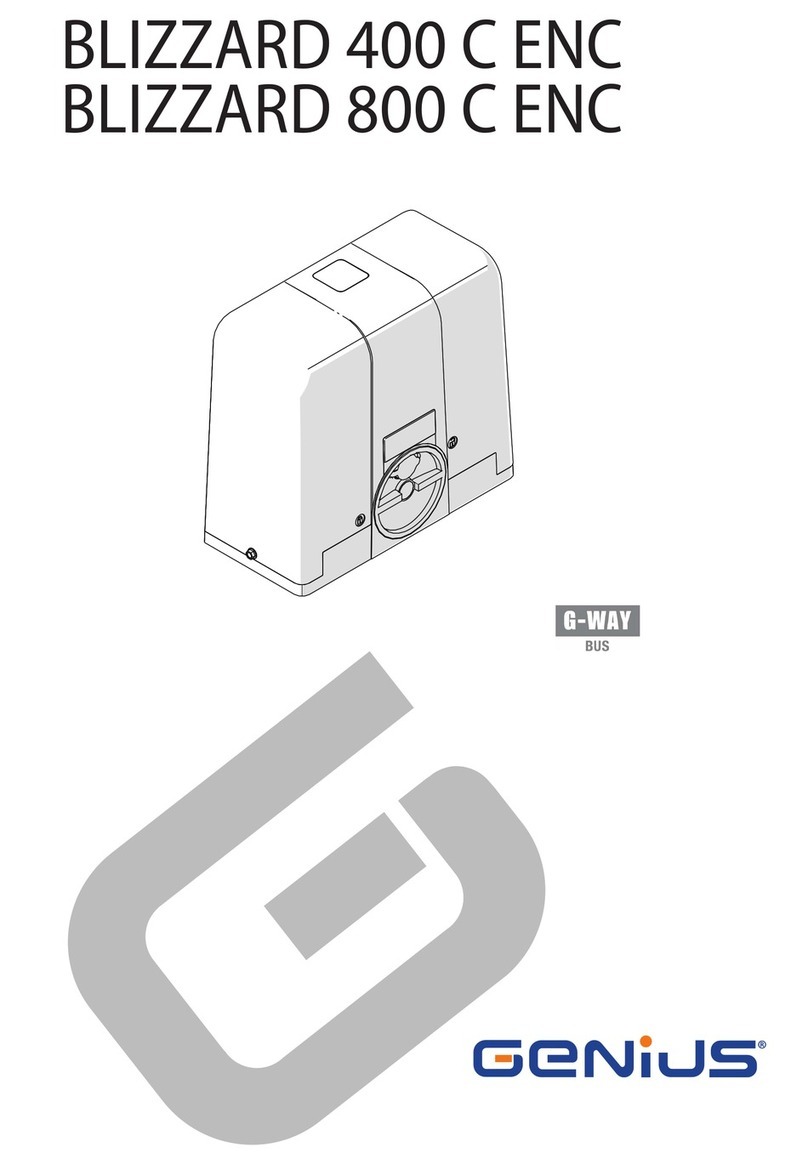
Genius
Genius BLIZZARD 400 C ENC instruction manual
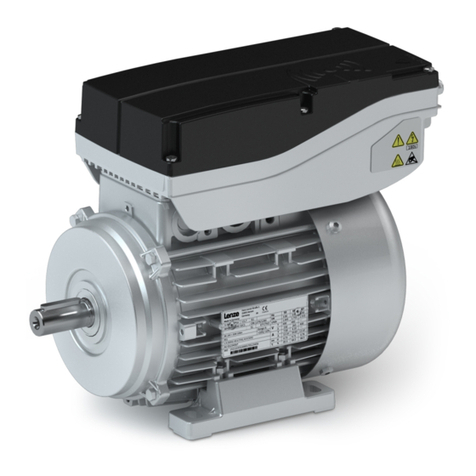
Lenze
Lenze Smart Motor m300 Mounting and switch-on instructions

Northern Lights
Northern Lights M844W3 Operator's manual

BREL
BREL BZE45 manual
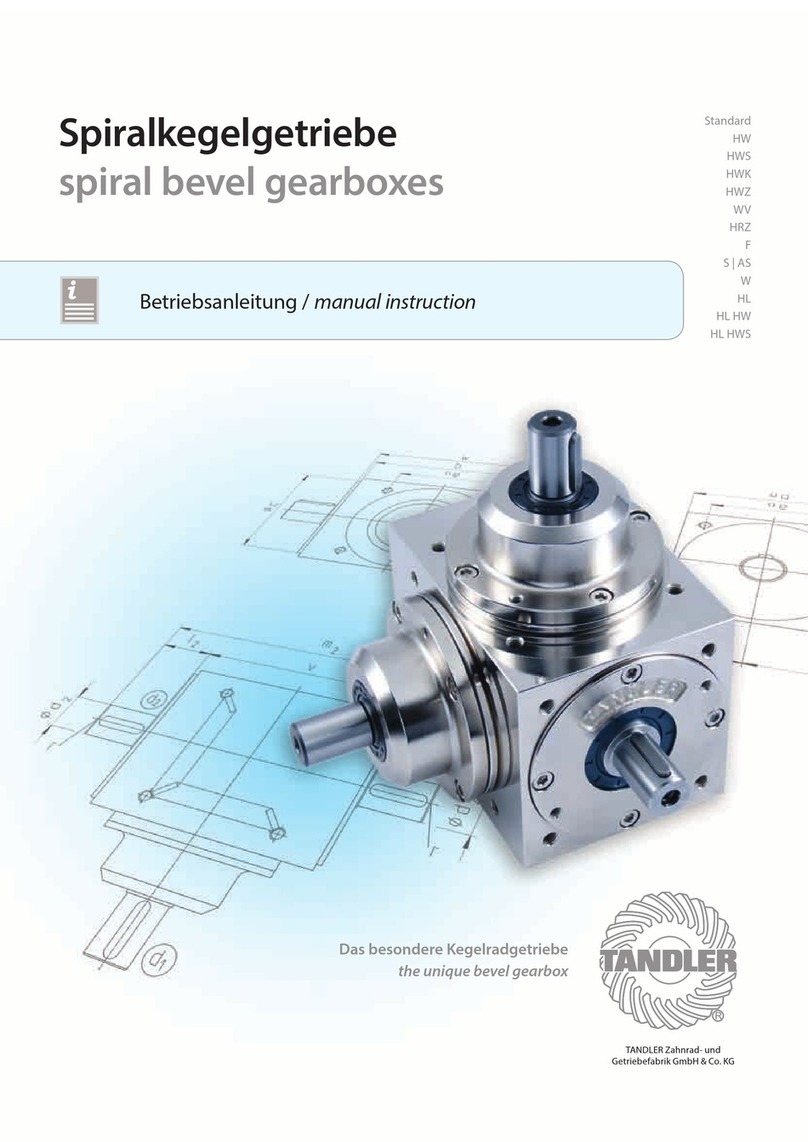
TANDLER
TANDLER Standard Manual instruction

Briggs & Stratton
Briggs & Stratton 42A700 Series Operating & maintenance instructions

Vestamatic
Vestamatic VL-ME-230-45 Series Installation and operating instructions
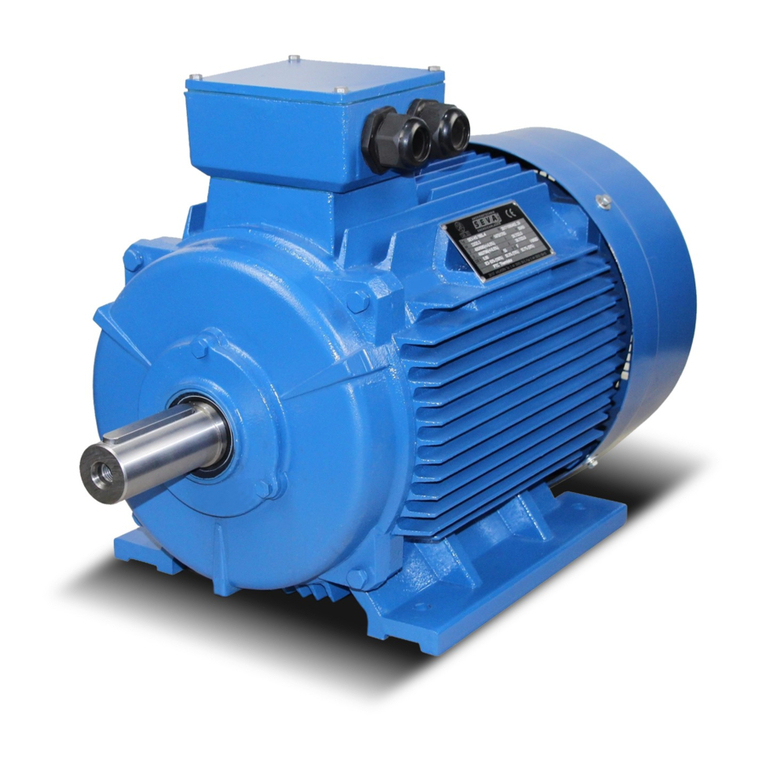
Seva-tec
Seva-tec MS Series Operation manual
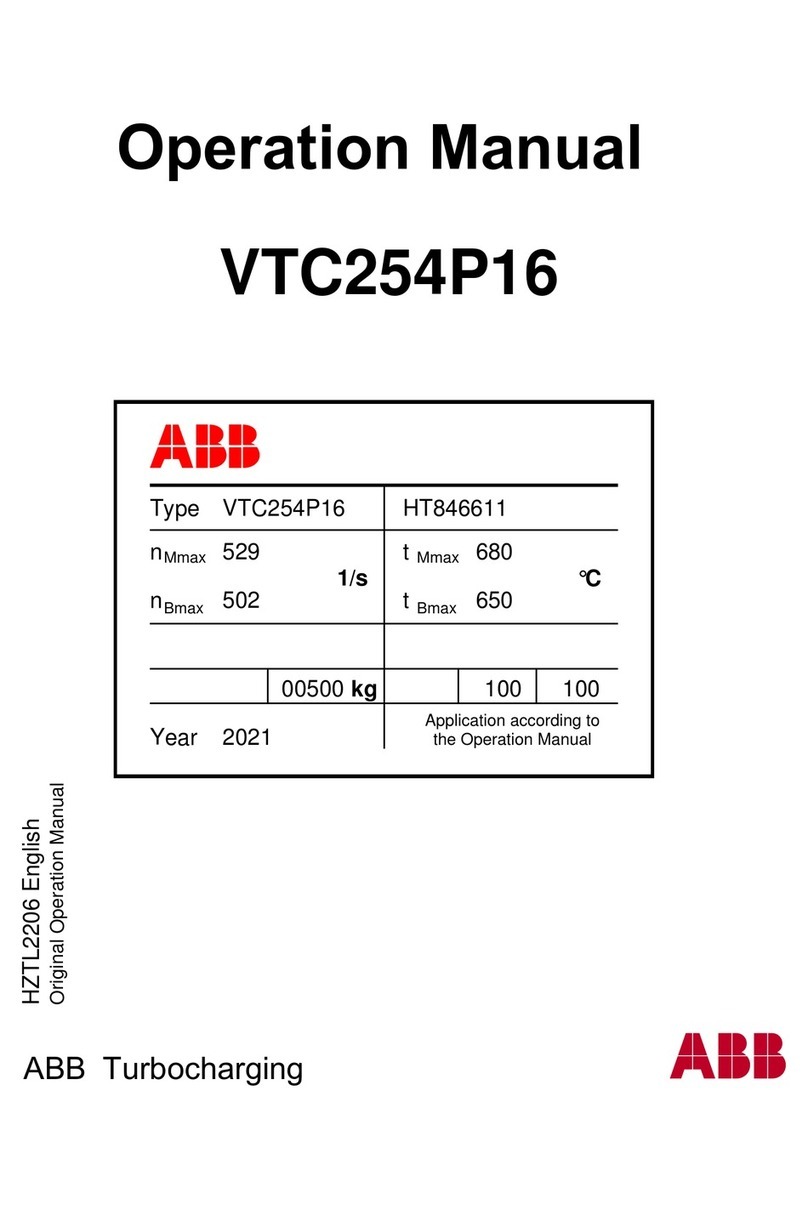
ABB
ABB HT846611 Operation manual
